#I did not program javascript for 8 years for this
Explore tagged Tumblr posts
Text
posting this here bc my friends told me "hey just ask reddit! they'll respond" so I listened to them like an idiot. I got no answers. so I play mc java on Mac and said friends made a server for 1.18.2 (modded) and I just cant get it to load. even in single player vanilla mc. it'll load everything just fine, and then get to the bit where it says its loading terrain and then just... freeze indefinitely. spinning wheel of death and all. it only does this with 1.18.2 for some reason? any tips to fix it or am I just cooked?
#minecraft#minecraft java#minecraft mods#minecraft glitch#Minecraft glitch help#mineblr#mineblr save me#macOS issues#minecraft 1.18.2#may be relevant but I play on a MacBook Pro#Minecraft MacBook issues#I did not program javascript for 8 years for this#modded minecraft#vanilla minecraft
2 notes
·
View notes
Text
Andy's 2024 Year in Review
I tend to work on a lot of small projects with a smattering of larger ones mixed in. Often I end the year thinking I didn't do all that much, but then I start going through my posts and realize that I did more than I thought! Hard to believe that stuff I did last January was this year!
I've fallen out of the habit of doing these year-in-review posts, which is a shame, but I'm turning that around right now! Here's a quick look at all the things I made last year.
EMMA

Probably the biggest thing for me is another successful year of the coop I'm a part of, EMMA Technology Cooperative. After a somewhat tough 2023, we bounced back this year. Seeing us survive a lean time and watching the coffers refill in the past year really drove home the value of organizing around cooperation as opposed to infinite growth. And if you're reading this and in need of a creative technologist, please drop us a line!
Taper - January

A the start of this year I was on the editorial board of Taper, online literary journal for computational poetry. I only assisted with one issue (which I also contributed to!) but it was a very new experience for me and I'm happy I could be a part of it!
A few years ago I kind of stumbled into the occasional piece of digital poetry without ever realizing. I was doing a literal poetry reading when I realized that I write poems from time to time. It's very fun that my practice occasionally pulls me in unexpected directions.
MAGFest - January

Every year, we bring all of the games in the Arcade Commons collection to the Music and Games Festival just outside of Washington DC. It is our biggest show of the year by a mile and I love it every time. There is a DIY spirit to MAGFest that really sets it apart from any other con I've been to. We're well underway for 2025 as I write this. As I frequently do, I emceed a bunch of our tournaments.
The Algorithm - February

What a fun project this was! Alia ElKattan and Lujain Ibrahim contacted me about their Mozilla Foundation-funded project to explain how algorithmic feeds work. I created modular P5JS animations to serve as the "content" for their app.
They found me via the P5 tweetcarts I had been posting during the pandemic. I got to explore some of those same ideas without the super tight character restrictions.
Check it out here.
EMMA Skillshare - March

I did a small workshop on getting PICO-8 to communicate with Javascript. This was the basis for my project Pico Pond which I wrote about on the EMMA Blog.
This skillshare took those ideas and presented them in a livestream, which you can watch here.
Our Generation - May

I was contacted by Nick Montfort to submit a piece of computer generated poetry for a small-run book called Our Generation: Programs + Computer-Generated Texts. I channeled my inner Jenny Holzer for this and really enjoyed it. The full src appears at the top of the page and it was interesting to factor that in to make sure the output exactly filled the page. I keep thinking it would be fun to do a series using this size restriction but I haven't done it yet.
You can see my full page here.
Tastebud Tapdancer - May

You've been swallowed by a giant serpent but you're trying to make the best of it.
A little video game with a source code of just 500 characters! Made for TweetTweetJam 9 You can play it here.
The Indomitable Rocket Dog - June

Around this point in the year is where I started working on my current project, The Indomitable Rocket Dog. I'm enjoying this game so much. I haven't made a real twitchy arcade game since PARTICLE MACE, which just celebrated its 10th birthday. It is still very early but I feel really good about this one!
After MAGFest 2024 I was percolating on physics-y arcade games mostly because I am so deeply in love with Hoverburger by Nick Santaniello. Before I knew it my love of N++ was mixed in there as well.
I'm writing all of my own physics in C++ because I had a vague sense of how I want it to feel and it's a hobby project so I can do what I want.
I've been documenting my development on it in a mastodon thread.
Isabelle Poppy And Bling - August

OK, this one isn't new at all! This is a flash game I made in 2009 for musician Justin Braun. But this year I got it playable on the web again!
Like so many game developers my age, I got my start with Macromedia Flash. This game felt like the culmination of my style at the time, which was heavily influenced by Animutation. I was starting to be more deliberate with my collage style as opposed to aiming for totally random elements. I think I got paid $600 for it, which felt huge at the time.
1K Pac-Man - September

Another size coded game. This time it's as faithful a recreation of Pac-Man as I could muster in 1024 bytes of source code. All of the ghost logic is accurate to the original!
You can play it here. I'm very pleased with the mouth animation.
I made it for PICK-1K Jam 2024. I do wish I had read the page a little more carefully though. The jam required compressed source to be 1024 bytes and I did raw source. The game is only 723 compressed bytes so I had a lot of room to expand, but by the time I realized that I had painstakingly trimmed and optimized my code and I couldn't imagine untangling it. Oops.
Cloud Gobblers - November

Arcade Commons received a grant from the Brooklyn Arts Council to create an arcade machine showing a collection of games that incorporate weather data into the gameplay. EMMA was commissioned to make one of the games. Cloud Gobblers is a snake-style game where the playfield is a video satellite field of global cloud coverage over a period of 48 hours.
This was the first time all of the members of EMMA worked together on one project!
Three Tapestries - October

I didn't make many pen plotter drawings this year, but I really liked this one. You can see the full thing here.
It's currently still available in my shop! Until somebody buys it it will be hanging on the wall in my office.
Lever Up Jam - December

Back in 2021, I worked with Matt Lepage on an alt-control game jam called Jam Jam Revolution. We prepped a parts list so all participants could build the same controller and make games for it. This year we decided to dust off that idea with the Lever Up Jam. This time there will be a full-sized cabinet at MAGFest that the games can be played on!
My favorite TweetCarts / Postcarts This Year
I no longer use Twitter, but I have been making the occasional tweetcart (a PICO-8 sketch with source code 280 bytes or less) and posting them on tumblr and mastodon. But there was an exciting development towards the end of the year! Lexaloffle, the creator of Pico-8 created a section on the BBS for 300 char or less "Postcarts", so we now have a centralized home for these little byte-sized demos.
Here are three of my favorite postcarts that I made this year:
Spinning Cube v3 - April

p=pset::_::cls()for i=0,99do u=0s=i/4+t()/5x=64+sin(s)*39a=64+sin(s+.25)*39y=39+cos(s)*9b=39+cos(s+.25)*9line(x,y,a,b,6)for k=0,99do if x>a and i<4and k<50then line(x,y+k,a,b+k,k>48and 7or 9+i)p(x,y+k,7)p(a,b+k)end v=pget(i,k)u+=v if(v>6)break if(u>0)p(i,k,8)end end flip()goto _
Big year for making things spin. You can check out my tumblr post to see all my attempts at perfecting this spinning cube. The outlines were the real cherry on top for me.
Balatro Spinning Card - May

a=abs::_::cls()e=t()for r=0,46do for p=0,1,.025do j=sin(e)*20k=cos(e)*5f=1-p h=a(17-p*34)v=a(23-r)c=1+min(23-v,17-h)%5/3\1*6u=(r-1)/80z=a(p-.2)if(e%1<.5)c=a(r-5)<5and z<u+.03and(r==5or z>u)and 8or 8-sgn(h+v-9)/2 g=r+39pset((64+j)*p+(64-j)*f,(g+k)*p+(g-k)*f,c)end end flip()goto _
This was so hard to make! I can't believe I did it. I wrote a giant writeup breaking down the 279 byte source code on the EMMA blog.
Fuji - October

pal({7,12,140,13,129,1,5,8,8,14,142,143,7},1)r=rnd::_::x=r(128)y=r(128)c=9+y/26-2+r(1.5) if(y<((x+40)/6)^1.6and y<((178-x)/6)^1.6and y<79+r(2))c=2.5-sgn(y-45-sin(x/21)*r(4))*1.5+r(2.5-sgn(x-69-r(8)-y/3+25)*.7) pset(x,128-y,c)a=r(1)d=r(25)pset(28+sin(a)*d,30+cos(a)*d,9)goto _
I made this during some downtime on a vacation to Japan. I was hoping to see Fuji the next day and the clouds wound up being kind to us, giving an amazing view.
I almost never make representational art and I was really happy with how this turned out.
That's it! I hope you all have a great 2025!
2 notes
·
View notes
Text
Week #3
Introduction
For this week I knew I needed to spend a little time narrowing down what I wanted my topic to be. Next week I plan on spending most of my time on that task but I still need to do some thinking now because I’m at a point where I’m encountering recurring issues:
Issue #1: I know I want to do something personal relating to finding one’s identity and how hard that can be growing up when you feel othered or like you don’t belong. I just don’t know if I want to use the lens of nostalgia, horror, or both to convey feelings of discomfort? I’ve enjoyed the research I’ve done but I just don’t feel totally set on that yet even though I spent the last two weeks largely looking into it.
Issue #2: I haven’t seen a lot of horror? It’s a genreI stayed away from for so long, and it’s only been a recent thing that I’ve felt like I want to explore more and I feel drawn to, but I'm not knowledgeable on the subject so I need to decide if I want to pivot off of this or not. I think the form of horror I’ve consumed the most is through video games so I could spend a week diving into that.
I am hoping my research this week leads me in the right direction.
Research
I sent out a google form this week asking questions related to horror/thriller genres in media people consumed growing up and how they might have been affected by them. I also wanted to know why people really like these genres or why not.
Do you consume media (games, films, TV, books, videos) containing horror/psychological/thriller elements?
When you were a teen/preteen, what were some of the memorable pieces of media in those genres that you consumed?
Are you drawn to these genres? Why or why not?
Do you remember any media in these genres being particularly nostalgic for you?
Are you easily scared or frightened? Did/do you have a lot of nightmares often now or when you were younger?
I sent this out on monday to some friends and as of writing my blog post I’ve gotten 8 responses. There is a wide variety of answers which I’m very happy about. I found it interesting that I had responses in all 4 quadrants of this table.
Enjoys horror and gets scared easily
Doesn’t enjoy horror and attributes that to getting scared easily
Enjoys horror and isn’t scared easily
Doesn’t enjoy horror and isn’t scared easily
The question about nightmares led to some interesting thought processes and I might look into that more. Like I had one person say that they are super anxious and got a lot of nightmares as a kid but don’t like horror not because it’s scary but because they find a lot of it to be “cheesy”. Another person said they have to watch horror media during the day which I definitely relate to. It reminded me though how the dark is an extra layer of scariness because of the unknown that comes with not being able to see your surroundings well.
Overall there’s a lot more that I learned from the responses so far and I think it helps me find some more things to look into as potential points of views surrounding maybe the eyes and identity or nightmares and identity etc.
Creative Research
One of my friends had mentioned I should look into OpenProcessing, which is an online platform that allows people to share and explore creative coding projects made with p5.js and other programming languages. It's like a social network for artists and programmers, where you can find, showcase, and collaborate on interactive artworks and visual experiments. I just started learning JavaScript and using the p5 library this year and the generative art side of the website drew me in.
Some examples of cool things that I was looking into on the website:

https://openprocessing.org/sketch/1270210

https://openprocessing.org/sketch/2065676
https://openprocessing.org/sketch/2095152
Over the week I ended up looking into tutorials on the basics of making sketches. This one guy has a good series on different topics like shapes, loops, color, trig functions, noise. I just spent time learning more about generative art and I think these skills can help me in the future of wherever I head in my project.
youtube

Reflections
This week I think I gained some good insights. I know I want to work with identity and research something related to that pain and discomfort that comes with trying to find your identity, especially growing up in the preteen and teenage years. My creative research was not connected really to my reflection but I do think I will use what I learned in the future of my project. I know for next week I will continue to expand upon what we worked on in class with identifying a point of view and I have some really good ideas I just need to look for gaps in information now.
2 notes
·
View notes
Text
What is Async Anyway?
Explaining async/await and general concurrency concepts in programming languages.
A lot of modern languages have async/await syntax built directly into them, and the construct can be extremely useful. Examples of languages that include these concepts are JavaScript, C#, Python, and Swift, and even modern relatively low-level languages like Rust have this syntax. Even though it's usually thought of as a more advanced feature, I think it is really not that hard to use once you get the hang of it, and it is super useful and rewarding when you really understand it.
This is going to be a bit of a long and pretty technical post, but I hope it can give you some confidence to know what async/await really does when you use it, and maybe it can help you use it more effectively. Keep in mind that I will not be able to go over everything in super deep detail, and that I am going to simplify stuff, but it should give you an idea how these systems work.
I am a little curious about eventually following this up with a post looking at how these systems compare under the hood in different programming languages, so let me know if you'd be interested in that.
Big post under the cut.
Parallelism and Concurrency
Computers today can do many things at the same time. And I mean that literally: in one instant, a modern CPU can be working on multiple instructions. That's because a single CPU has multiple cores that can all execute code (mostly) independent from each other. This is called parallelism, and the way we as programmers interact with that is through threads. Most programming languages, especially "lower level" ones, have a way for programmers to create a thread that will run some part of your code. Creating a thread is telling the computer that it can, and should, run the code in your threads in parallel (although various systems such as the OS still have discretion over when and if that actually happens).
Parallelism is not quite concurrency tho. Where parallelism is about your computer literally doing multiple things at once, concurrency is about your computer doing multiple things, but not at once. With concurrency, you kind of pretend you're doing a parallelism. But in reality, stuff doesn't happen at the same time. Instead, your system (runtime) does some work on task A a bit, then on task B, then maybe again on task A, etc., but doesn't work on the two at the same time. So, in a concurrent system it might look like task A and B are progressing simultaneously from the outside, but work actually only happens in sequence.
Let's Talk About I/O
I/O stands for input/output and describes data in your program that comes from elsewhere, or that gets sent elsewhere. So for example, user input is I/O. And similarly, a web request can be I/O, whether you send it or receive it. So let's use that as an example: you send a web request to some API to fetch you the cutest bunny images and facts:

But the service is taking its sweet time to respond.

Fact: Loading bunny fact…
With how we did it here, we halt execution of the entire thread until the response comes in (at least in most languages, more on that later). In this case, we call get a blocking method because it, well, blocks the thread without actively doing useful work.
What if we could instead use the thread for other tasks instead of just sitting there, twiddling our thumbs and waiting on the server? This smells of concurrency…
Callbacks
Callbacks are a way for programmers to avoid that period of thumb twiddling. The new getWithCallback function now returns immediately, but it doesn't return a value. Instead, we have to register the code we want to run once the server responds with the function:

The function we pass to getWithCallback is called the callback, and it gets called by the client* only once the response arrives. Oh look, here it is:

Fact: A rabbit's life span is about 8 years, though sterilized rabbits (those who are spayed/neutered) can live as long as 10-12 years.
*"The client calls it" is a big simplification, there might be a lot more stuff happening here. But the important bit is that the client magically does not need to block to wait for the response.
Promises and Futures
What JavaScript calls Promises and what a lot of the other languages call Futures is essentially sugar sprinkled on callbacks - it makes our callback code a little nicer. Callbacks can commonly create a concept called "callback hell", where you have to call a function that takes a callback inside the function that takes a callback inside the function that takes a callback…
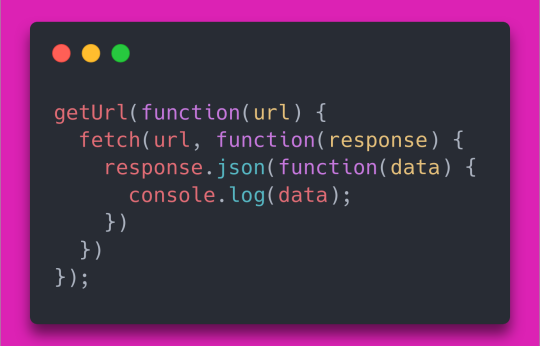
(Code modified from https://developer.mozilla.org/en-US/docs/Web/JavaScript/Guide/Using_promises)
To avoid this, functions now can return a Promise instead of taking a callback. Promises represent the promise that, while a concrete value might not exist right now, it will in the future. Once the value exists, we say the Promise resolves. The code above with Promises would then look like this:

It still doesn't look perfect, and there are things you can do to make it look a little nicer, but it's so much less nested. The callback in the then function will be called once the value is ready, and the callback itself can also return a Promise. The then function then returns a Promise which will get resolved once the future from the callback is resolved. Many other languages have a concept similar to JavaScript's Promise, and it's often called something like Future or Task (because it would be too easy to have consistent naming across languages).
Now keep in mind neither of those solutions above are really "concurrency" in the definition we used above. This is because the thread we call, for example, getWithCallback on still completely belongs to us. We could keep using it, and we would not get interrupted to execute the callback. Depending on the language and runtime, the callback might get executed on a different thread, or the runtime might have to wait until we are completely done with what we were doing to then use our thread to call it. The same thing goes for the callbacks in the then method of promises.
Async/Await
And async/await is just some sugar and magic fairy dust on top of Promises (or Futures or whatever). It makes our code look like it should be blocking, but in reality it isn't. Here's what our bunny image code looks like with async/await:

So here, a couple things happen. First, the Promise is created and the web request is initiated. Then, the Promise is awaited. For that, (if the Promise is not resolved at this point already,) the task first yields, meaning it tells the runtime that it is not doing any useful work at the moment, and that the thread it ran on can be used for other tasks. The runtime then makes a note of where to continue execution when that Promise resolves, and looks around for other tasks that currently need executing to put them on that thread. After a while passes, the Promise resolves, and once the runtime has some resources available for us (maybe because another task just yielded), execution on our original task is continued with the API response.

Fact: A rabbit's teeth never stop growing! Many people believe they need to chew to keep their teeth short. While they do enjoy chewing, it's the normal wear from where their top and bottom teeth meet that keeps a rabbit's teeth short.
This is more in line with the concurrency we sought out above. We can interleave other computations while our task is still running, but during times where it is not doing any useful work. (Still, because you may have multiple threads your tasks can run on and move between, it might not always be 100% technically accurate to call this system concurrent.) This is also why it is important to not block for long in async contexts: if you're hogging the thread for too long, you're stopping other tasks from progressing and throwing a lot of the benefits you gained from doing it concurrently in the bin. Most async runtimes will give you some option to run expensive or blocking code elsewhere, so that you can keep the benefits you gain from async.
So that's the explanation what async/await does, and the broad strokes of how it works. If you have any more questions regarding the topic, feel free to ask! I think it'll be fun to occasionally write a longer post on interesting things I've learned, so if you have topic suggestions, don't be afraid to tell me!
Further links and sources
Don't Block The Event Loop! - Why you should avoid blocking in Node.js, and what pitfalls to look out for.
I got the bnuuy images and facts from the animality API. The licenses on the images are not super clear, but I'll assume it's okay for me to use them here with credit because it's an open API.
I lifted the definitions and some of the explanation for parallelism and concurrency from Steve Klabnik's talk on Rust's Journey to Async/Await. The talk is more technical and very focused on Rust, but it's a great talk.
I referenced the mdn web docs at various points, they're a great resource.
I created the code screenshots using the carbon app.
#codeblr#coding#programming#progblr#javascript#wow this was something to put together#uh yea thanks for reading#I really liked writing on this#just discovered codeblr recently and was instantly motivated to write a kind of “explanation from the ground up” thing#but I feel like there are some places where I can improve my explanations and such#still learning how to write this stuff and I think I kinda just want to get this out there at this point#I hope it can help someone out a bit or that someone finds this interesting#long post#God I Wish Tumblr Supported Code Blocks#the writing process didn't contain as much research as you might think#I picked up this stuff slowly over a long time and I can't possibly source where I got all of that from#doing posts that I need to more actively research for could also be fun#just challenging myself to learn more#but yea really feel free to ask questions I know this stuff is confusing and I didn't phrase everything perfectly#asks and messages are open#okay I'm going to sleep now goodnight
2 notes
·
View notes
Text
So I work as a programmer, and the languages I use and the manner I use them in get kind of weird:
- I use python, but only to program the one robot that internally runs python. The dev environment is “here’s a box you can put text, see if you get runtime errors”. If you want a proper dev environment, you can copy-paste code from the robot program into an editor of your choice. They do have a top-level graphical interface if you want each line of code to take up 10% of your screen.
- There’s a language that’s not quite C++ that we use for a different control box. That one’s dev environment will tell you if you made an error when you try to download. Specifically it tells you the first error, and you have to fix it and try to download again to get the second error. The download process takes 20 seconds. If you try to compile offline you get separate errors.
- On the more normal side of things, we have an SQL/ajax/javascript/html thing for handling some of our internal processes. As a change of pace my problems for this one are self-inflicted, because I never figured out how to set up a proper dev environment and just edit everything in notepad++. Someone else finally showed me how to do local environment testing so I no longer take our internal website down if I miss a close bracket.
- We do a ton of stuff in .NET framework, because 20 years ago my work was using VB6 and we never bothered to migrate to C#. I actually have a real dev environment for this one with autocomplete and syntax checking, so of course it’s my favorite. My boss wants to switch this all over to javascript so we can do android/linux deployment.
- A different robot has an internal language that’s not quite python. This one also has a graphical interface that I won’t use because I want more information to fit on my screen. This one also only tells you about syntax errors during runtime, but the most noteworthy thing about it is that the command to move the robot in a straight line is bugged. I think they fixed it to the point where you can’t reboot the controller by telling it to move in a straight line, but you can make it slowly drift off into space until it faults.
- The ladder logic we use is actually normal (for AB, not Seimen’s), but I did add basically a secondary control layer built out of function blocks to handle sequencing. It is very well-documented, a fact that no one cares about when they ask what the heck I am doing with so many function blocks.
- The ladder logic was a little too normal (expensive) so they also make us use the budget version. It’s very similar except there are no keyboard shortcuts, everything takes more clicks, and instead of changing code live you have to reboot everything and wait about 30 seconds if you want to change something.
- There’s a language we use for one of our internal products that I created over about three days because I didn’t want to worry about malicious external code or figuring out a compiler. The parser is just squashed into an entirely different program so that program can control stuff in the background. It does not have arrays or loops, and I didn’t give it string handling for about a year. There’s no dev environment because it’s not a real language. Something like a quarter of the stuff we sell now uses it.
- One of the robots requires programming via menus. If you want to add an if statement, the menu shortcut is F1 -> 4 -> 8. The end if is F1 -> 4 -> 0 -> 1. The program to let you type is a paid add-on. Exponents and absolute values are also paid add-ons. You get 200 numerical memory registers and can’t have local variables. There is no else if.
#hi I’m Kate#I have had arguments with engineers at three major robot companies#please don’t be too mean about the notepad++ thing#you can be mean about the internal programming language thing#but this post is me bragging#my work is cool and weird and nonsense#I will bite the next time someone advertises their robot as no programming required
1 note
·
View note
Text
Legacy Writing Junk
Long before computers, people were building things with intelligence. Take the simple toilet. It sits patiently until a flush, then automatically turns on a valve and turns it off when the tank is full.
Today, we have devices with mechanical, electrical, and computer intelligence ranging from this simple toilet valve to an aircraft carrier loaded with planes, computers, missiles, radars, atomic reactors, satellite navigation, and even devices that toast bread to perfection.
Along this path to greatness, some less-than-perfect systems were invented, and despite better alternatives, these appalling technologies are still widely embraced. The one I dislike the most is called ladder logic, but it requires a lengthy explanation.
In the 20s, engineers began using electricity to control machines, including switches, motors, lights, and relays. Elaborate systems were developed using these basic building blocks; an elevator that services multiple floors is one example.
Long before computers, elevator control panels had 20+ relays that took information from the floor buttons and controlled the motors. But how was this complex system documented? Enter the ladder diagram.
One or more vertical lines on the left/right side of the page represent system power. Connecting these two vertical lines are horizontal lies with symbols representing motors, switches, lights, and relays. These make up the ladder’s rungs and show how the components logically interact.
Ladder diagrams are still the default for industrial products, but what if we want a more complex system? Along came the computer, which could apply far more logic than a bulky relay.
We call such computers Programmable Logic Controllers (PLC), which use the same technology as in a microwave oven, dishwasher, or washing machine. But there was a problem. What about all those industrial technicians who understand ladder diagrams? They cannot read a computer language like BASIC. The solution was Ladder Logic, which uses the same visual format as a ladder diagram with additional computer logic symbols.
What’s the problem? This visual programming language quickly breaks down when a program gets complex. For example, controlling an everyday device like a printer with ladder logic would require hundreds of rungs. The visual result is challenging, even for the most experienced ladder logic programmer.
When I first saw ladder logic, I thought, “Why not use a flow chart or a standard computer language like C, Python, or JavaScript?” “It is not industry standard.” The more I looked, the more apparent it was that the PLC developers were using all means available to maintain a very outdated concept.
Despite my meager protests, technicians will use ladder logic for the next thousand years. Why am I bringing this up? This series of articles is supposed to be about writing and stuff. Let’s discuss all the legacy junk in writing, books, and publishing.
How about 3x5 cards? Where did those dimensions come from? An 8.5”x11” page? 8.5 inches? Not 9 or 8? Legal sized? Now, I sort of understand Tabloid (11”x17”) because it is two 8.5”x11” pages. A0-A10 paper sizes use an aspect ratio based on the square root of two? Who came up with that? Pythagorean? Here are the standard book sizes:
General Nonfiction, YA Dystopian, Fantasy, Sci-Fi: 5.5” x 8.5”
Thrillers/Mysteries, General Self-Help, Memoir: 5.25” x 8”
Inspirational/Spiritual: 5” x 8”
YA General Fiction: 5” x 7”
General Fiction: 6” x 9”
Why so many sizes? Tradition? Federal law? The secret paper cartel? Wait a minute. Printers use A4 or 8.5”x11”. Why not make all books one of those two sizes? Imagine how much money we could save. Imagine how nice it would be to have a book shelf loaded with identically sized books.
The Oxford comma. What the heck is that? I before E except after C. Did we base our entire spelling system on a nursery rhyme? Every sentence needs a subject and a verb. Do the police arrest writers when the subject is missing? Drive on the parkway and park on the driveway. I give up.
A sentence starts with a capital letter and ends with a period. Did the cave dwellers use capital letters in their drawings a million years ago? Proper nouns require a capital letter. Who decides what is correct? The words its, and it’s are two words with different meanings. I don’t know, they look the same.
A character requires motivation. I do stupid things without reason, permission, motivation, or logic all day. In fact, I am good at it. The plot better have conflict. Can’t we just get along? A good story has a twist. Isn’t life confusing enough without writers intentionally confusing readers? Don’t make your main character arrogant. Every day, I run into arrogant people. Why can’t I write about them? Show the emotion, don’t tell the reader. So, “I’m sad” is invalid. Exactly.
Roman numerals? 1988 = MCMLXXXVIII Really? How about alternate spellings? Color, colour. Reads right to me. Disused words that are still in the dictionary? Groak – To watch someone silently as they eat. Elflock – If you have wavy hair and wake up tangled. Lunting – Go for a walk and smoke a pipe. Lethophobia – Fear of oblivion. Do dictionary editor’s keyboards not have a delete key?
Double spaces after the period? That’s a lot of wasted paper. Double-spaced documents? Even more wasted paper. How about the keyboard keys that never get used: Print screen, scroll lock, pause, and insert? Is there no end to legacy junk?
What font should I use? Arial, New Times Roman, Bookman, Helvetica, Baskerville, Times (Shouldn’t this be Old Times?), Akzidenz Grotesk (That is a thing?), Gotham (Batman’s font), Didot, Futura (Philip J. Fry’s font), Sans, Comic Sans (Superman’s font), Rockwell Monotype, Sans-Serif (If Smurfs had a font, this would be it), or Franklin Gothic. Should the font be bold, italicized, underlined, double-underlined, subscript, superscript, strike-through, double-strike-through, small, large, colored, transparent, hidden, tilted, small caps, or all capitalized?
Here is what it all boils down to. I recently emailed a friend, “The firesfighters are earning their pay this week.” Did you understand that sentence? Of course, but your eagle eyes identified a minor mistake. I made an innocent typo with the word firefighters. I corrected it, and that was it.
But… Did I have to fix the error? The original text was excellent. But no, the chaotic English rules are clear. Alternate spellings are not allowed. Correcting this mistake is a very high priority. Yeah, I will get right on it. I might even include an Oxford comma, change the font to blue, double-underlined, bold Akzidenz Grotesk, and publish it in a 5.25” x 8” book while lunting and thinking about lethophobia.
You’re the best -Bill
January 29, 2025
Hey, book lovers, I published four. Please check them out:
Interviewing Immortality. A dramatic first-person psychological thriller that weaves a tale of intrigue, suspense, and self-confrontation.
Pushed to the Edge of Survival. A drama, romance, and science fiction story about two unlikely people surviving a shipwreck and living with the consequences.
Cable Ties. A slow-burn political thriller that reflects the realities of modern intelligence, law enforcement, department cooperation, and international politics.
Saving Immortality. Continuing in the first-person psychological thriller genre, James Kimble searches for his former captor to answer his life’s questions.
These books are available in softcover on Amazon and in eBook format everywhere.
0 notes
Text
Exam days
I woke up at 5 am today.I didnt sleep again (actually i used to).I studied and went to college at 8 am.Classes starts at 9 am.The exam was easy but there was a tricky question that i thought i did correctly but NO ,after talking with my friends i realized that i wont get any marks on that question.Yep, I'm somewhat disheartened.But its okay right?!! i preapared well and i could do better in second internals.
There was a transfer student in my class.I dont know how she is gonna cope with the new college thingy yk.Just imagine,two years into a college and you are transferred to new one just to spend another damn whole year with new people,professors. cant even think about it,my introvert self is screaming at me.Hopefully she would get with the new change i guess.
i cant anything other than preparing for exams .You know what i hate talking about exams.I wanna talk about javascript,html,css,python and how i am improving myself on those coding languages (yeah html and css arent programming lang).Four exams to go :/
I am thinking of starting a podcast.I like to speak infront of people and i kinda started a podacst and released a episode but i couldnt continue it (procastinated terribly) and omg the editing takes hours and thats leading to the deletion of the account.Now i want to do podacst again because there was a girl in my class was asking me "NEXT EPISODE WHEN?" See i've a loyal listener somI wanna do podcast again.
wow its 12.56 pm here WAIT FR???? I wanna wake up early and prepare for my cryptography exam.
Remember, it's okay if things don't always go as planned,learning and growth take time.
runs*
1 note
·
View note
Text
ok this turned into a whole ass rant so it’s under a read more
look. i’m not a mean person. i really try to be kind and compassionate and take into consideration a person’s life outside of work and outside circumstances and etc etc. but i have literally never worked with another person as incompetent as my current direct report and I’M? JUST AT THE END OF MY ROPE????
granted i’ve never seen her resume bc she wasn’t hired to work under me; she was hired to do java development and dev/ops. apparently she wasn’t making progress there, and bc i'd heard that she’d done react development in the past (and she told me as much when i took her on!!), i decided: ok. i can take her on as a team member bc HO BOY is there SO MUCH web dev that needs to be done on my program
it’s been 8 months. it’s been 8 months and she still does not understand basic FUNDAMENTAL javascript 101 concepts.
when i first gave her a task, she was really struggling and i was like ok. it’s a massive codebase. she probably hasn’t done react development in a while. i can understand needing onboarding/ramp up time. hell i did it in 2021 with another direct report who came in with react experience but needed to be onboarded onto my program. his onboarding took ~3 months, and after that i could rely on him to get his assigned tasks done.
it’s been 8 months and while there has been incremental improvement i should not still need to sit with her for hours on end pair programming with her to get basic tasks done like. even if it’s been 10 years since you last used a language!! you should still be able to pick it up within a few weeks or months!!
it’s like she walked onto my program with zero javascript experience. i’m not debugging with her. i’m not teaching her our codebase. i am literally hand holding her and teaching her the fundamentals of javascript and react.
I’M?! and like i’ve told my manager about this issue and i’ve tried to be understanding like maybe it’s been years since she last did react. it really does just take a while for someone to get used to a codebase as complex as this one. but she literally cannot do her job and it’s not my job to TEACH her coding. that is the PREREQUISITE.
and like. maybe it’s a fit mismatch. maybe she doesn’t actually know react and would be better off doing java. but she told me she has react experience and if you’re going to say to my face that you can code in react, then you better fucking be able to do it! and if you can’t do it immediately, then learn it on your own! i’ve given her tutorials. i’ve told her to take a break from my project to re-familiarize herself with react concepts. literally nothing is working.
and like. is this my fault???? am i not spending enough time with her? being effective at helping her succeed? but like. i have shit to do. i don’t have time to hand hold her.
GOD I’M JUST. and i’ve told my manager maybe we need to move her to another program. but between my feedback and the feedback from the prev person who was supposed to supervise her on java work which apparently didn’t go well either, no one wants to give her other work and like. she’s basically going to get fired at this point which is a SHITTY fucking position for me to be in bc i want to help her and I LITERALLY DO NOT KNOW HOW TO?
like. 8 months!!!!! it shouldn’t take 8 months to learn a new language! esp if 100% of your time is dedicated to doing just that! it truly feels like she just does not know how to problem solve or google or understand any basic programming concepts like even if ok you lied a little and aren’t actually that familiar with react how do you not understand a type error??? that is literally the first thing you learn in computer science 101 how the fuck can you call yourself a software engineer and not??? be able to handle type errors????
what the hell did she do at her previous company???????
2 notes
·
View notes
Text
girly girls

Pairing: Kang Taehyun x Fem!Reader
Word Count: 2.3K
Warnings: bullying, cursing
Genre: slice of life; fluff; angst
Summary: Three times a popular girl and a nerd were enemies, and one time where they weren’t
a/n: this fic was inspired by my all time favorite movie, Legally Blonde. I enjoyed writing this fic and I really hope you enjoy reading it :)

Y/N L/N has never been someone who liked to be cast in the shadows. Always being the center of attention, y/n has become one of the, if not the most, popular girls in her town. Homegirl is always dressed like an icon even when doing mundane tasks. Girls like her have never really been into anything “nerdy.” She associates herself with more of the bimbo kind, if you will. It was never really a secret, but she studies incredibly hard to get the chance to go to her dream school and become a great computer scientist. Being in such a large friend group of female fashion icons, there was never really anyone who wanted to talk about topics with math or computer science.
Kang Taehyun, however, is this awkward and incredibly smart boy. Never really associated with popularity, he’s only had about four friends in his life and absolutely no dating experience. He’d always been one to shy away from attention. At most times, he found himself quietly observing others. All this, and he’s still what you would consider the teacher’s pet. He gets all his assignments done, A’s on every test, and raises his hand for every question. As a computer science enthusiast, he has worked his butt off his entire life, filling his schedule with robotics clubs, different languages of code, and coding camps. Senior year was his year. He had finally got into his dream school, TXT Tech, and had already created a very very detailed plan for the future.

Currently, Y/n’s mother was constantly trying to persuade her about fashion school. Having an incredibly fashionable mom wasn’t always the best for situations like these. TXT Tech results were coming out, and even though Y/n was confident she was getting in, there’s still the chance she might have not. Nervously waiting in front of her laptop, she sits impatiently refreshing the page for her results. Within one sentence she hops up from her chair in awe. Obviously attending the school was going to be a big turning point for her, and she was so excited to have been admitted to TXT Tech.
As Y/n got settled on campus, she finds no one else that looks like her. Obviously, because she stands out, all attention is drawn to her. She’s confident, stylish, and hot. In a sea of gray and tan business outfits, Y/n wears a nice pink pantsuit. She’s relishing in all the attention, not seeming to mind that it’s not good, because she knew she looked good.
Her first encounter with Taehyun couldn’t have gone worse. Walking to her class, pink drink in hand, she struts confidently to the lecture hall for her computer engineering class. Not paying attention to where she was going, she bumps into a tall figure. This clearly wasn’t the best way you could go about your first day, but all Y/n could do was apologize.
“I’m so sorry, sir. I didn’t see where I was going and-” she rambled. Pausing in the middle of looking up, a very handsome and slightly awkward boy stands there, obviously pissed off and very annoyed. He scoffs and continues on his way to his next class.

Her second encounter with Taehyun was not great either. Clicking her high heels against the floor, she walks to her first class of the day. She had to get there early, she always had to sit in the front of the class. Taehyun on the other hand, nose buried deep in his book, walks directly to the middle. Despite loving programming, he could only handle so much attention. The class had started off well for Y/n, reviewing the class syllabus of “Principles of Programming Languages.” Taehyun, however, was pissed. He had not been called on once and was so frustrated.
“Y/n, can you tell me the five most commonly used languages of code?” the professor asks smugly. Y/n knew what he was doing. She was being set up. She knew he thought she didn’t know and that lit a fire in her.
“Python, Java, Javascript, C#, and C” she answers confidently. Hearing this, the professor nods his head. He wasn’t expecting that.
Taehyun saw this as a perfect opportunity. His hand shoots up and he comments, “Sir, that’s actually incorrect. C++ is actually more popular because although C has served as the foundation for writing languages like Python and Ruby, C++ is a newer language of code and therefore is compatible with more technology.” Taehyun confidently looks down to wear Y/n sits and smirks. Of course she wouldn’t know that. She’s only the popular rich girl that got in with Daddy’s money. She didn’t actually know anything, right?

It had been a few months since school had started, and finals were just about to come around. For this class’ final, they had to submit a partner project and code a simple game. At this point, it had been very blatantly established that Y/n and Taehyun were enemies. They despised each other. Always competing with each other in class, snickering when the other person got annoyed. It was a silent war between the two of them and everyone could feel the tension in the air. Obviously, it was no surprise they always came up at the top of the class, interchanging the first spot every test. What was surprising, however, was seeing their names together on the partner project roster.
Taehyun was furious. College was supposed to be his bitch, but now he’s acting like Y/n’s bitch. He was so pissed off. Computer science was supposed to be where he had the upper hand. The one place he could feel himself. Where he was finally better than the stupid popular kids. And yet, he’s here, competing with one of them. It wasn’t fair. She was a girly girl, she wore bright colors everyday, she even had a sparkly notebook. How was she so smart? There was no way, it’s just the laws of the universe. You had to choose between looks and intelligence. That’s just what the gods above said. There’s no take backsies.
It’s no secret that Y/n is a fashionable girl and having a female centric hobby isn’t really something applauded at this university. Knowing of Y/n’s insecurities, let’s talk about Taehyun’s. Having always worn non adventurous, boring, clothing, he’s known from the very beginning that Y/n’s beauty has helped her in life. Life is never fair, and it shows. Taehyun never ever got those advantages, and now here he is competing with someone just as smart as him.
As his jealousy grows in the back of his mind, he decides to use this time to take revenge. The next few days are spent typing away in the library, collaborating and researching for hours upon hours. Knowing that this project was worth 40% of their grade, they spent all their time trying to make this game perfect.
The day of the presentation of their near perfect game rolls around and Y/n was confident. She had spent countless nights coding this with Taehyun and on her own. Starting the presentation off, Taehyun pulls up a game completely different to the one Y/n coded with him. “In this day and age, gaming has become a hobby more popular than it’s ever been. With platforms like twitch and youtube, all different types of games can catch the eyes of a wide audience. With this in mind, I’d like to present to you Jackbox Party Pack 8. Roleplay games have become the genre of choice for many gamers to play, and viewers to watch.”
This was not the first person shooter Y/n had coded with him. What was he doing? Y/n stood there, not really knowing what to say. Opening and closing her mouth, she couldn’t form any words. She should have known this was a set up. “Ms. L/n, please continue.” The professor says. She couldn’t. She felt like she was frozen. She was so embarrassed and she should’ve seen it coming. With cheeks welling up in her eyes, she runs out of the classroom.
With a smirk, Taehyun continued on, explaining how the game worked and how he had coded it. He had spent the past few nights coding it by himself and he was incredibly proud. Paying no mind to Y/n, he stood tall and smiled throughout his entire presentation. Obviously, like any normal person, guilt started growing quickly in the back of his mind. He finally realized he had fucked up.

Running after Y/n, Taehyun felt incredibly guilty. He had taken the competition too far, and now he’d made someone innocent fail a required class. After running for what felt like hours, he found Y/n crying under a tree. He knelt down and offered her some tissues. Aggravated, she smacks the tissues away and tells him to leave.
Y/n, on the other hand, felt so angry. How could he do this to her? She hadn’t done anything wrong, and if he didn’t like the way she dressed or the way she conducted herself that was fine. All she needed was her to believe in herself and that got her into TXT Tech. While thinking about all the ways she could end Taehyun, she feels arms wrap around her. They’re 🤮Taehyun’s. Before she can rip his arms off, he speaks up.
“Look Y/n, I’m really sorry about that whole thing I pulled back there. I’ll talk to the professor and give him the real project. I really took it too far and I’ll do anything to make it up to you.” He begs.
“Um,, no? I don’t care? That was literally so embarrassing. If you really wanted to make it up to me you’d leave me alone.” Y/n pushes him off her harshly and storms off. How dare he? It probably took his two seconds to come up with that half assed apology. This was unbelievable.
Y/n started trudging through the grass back to her dorm. All she wanted to do was take a warm shower and cry in her bed. She hated everyone. She wanted him to suffer just as much as she did, but she couldn’t do that.

After two whole days of sobbing in her bed, she decided she was craving her signature pink drink. She really didn’t feel like going out, but delivering one drink would cost like $15. Y/n throws on a casual pink outfit. It’s very different from what she wore at the beginning of the school year, but the one thing that never changed was the color pink. Even in her depressive mood, she still wanted to dress up. She felt most comfortable wearing stylish clothing, that was her home.
Stepping into the store, she sees Taehyun sitting at a table alone. You know when you see old people sitting along and you feel so bad for them you start tearing up? Like what if they lost their spouse or something :(((((. So anyway, Taehyun gives her lonely old people energy and regardless of what he did to her, she decides to keep him company.
“Hey, um, can i sit here?” Y/n asks. Taehyun was so surprised. She wanted to sit with him? But he was so mean to her? He nodded his head and sat quietly. The past two days she could tell Taehyun had done a lot of thinking. She could tell he did it because he felt threatened. That wasn’t enough to forgive him, but at least she was being nice about it.
Taehyun gets up and leaves. He comes back with a pink drink in hand, maybe as an apology. “I really want to apologize to you again, Y/n. Yesterday I don’t know if you saw, but the professor graded the actual project instead, and I had told him everything and that I’d deserve it if he failed me instead.” Y/n wanted to be happy but she wasn’t. She didn’t want him to fail after helping her code the game with her. Maybe she was so nice to him because she had matured, or maybe because she felt something different in Taehyun. Even so, a little embarrassment, she thought, wasn’t enough to cause a person to fail their whole class. Holding his hand on the table, she nods, a silent way she decided to forgive him.
“Well, at least we’re not the worst team. I think group 7 coded a Niki Minaj roblox world.” Taehyun jokes.
She laughs. “That’s so funny, what the heck? I guess we just have some hardcore barbs in this class.” People like Taehyun and people like Y/n were never meant to be friends in the first place, but maybe now they were starting to. Y/n, who was always challenging the term “girly girl.” Who always stressed that you have to believe in yourself when the rest of the world is against you. Y/n who became successful, without changing who she was. Y/n, who was feminine and wanted to show that was never a weakness. And Taehyun, who was always unadventurous. Who was never into fashion but still managed to pull off his nerdy outfits with his cute face. The passionate Taehyun whose only hobby seemed like studying. Gossiping for hours at the cafe, they realized this. They were starting to become friends. No one ever expected them to even be able to hold a friendly conversation, but here Y/n was, challenging everyone again.
#txt x reader#txt fanfic#kang taehyun#taehyun x reader#taehyun fanfic#taehyun x y/n#kang taehyun x reader#taehyun headcanons#taehyun fluff#taehyun angst#taehyun au#txt taehyun#txt fluff#txt angst#txt reactions#txt headcanons
91 notes
·
View notes
Text
Friday Special #7
January 9th, 2021
So it has come to my attention that when people talk about RPG Maker the series, many aren’t aware of how far back the series goes.
Did you know that series dates back to almost thirty years?
That’s right, next year will be the 30th anniversary of RPG Maker!
So why don’t we have a history lesson into arguably one of the most important franchises in gaming history?
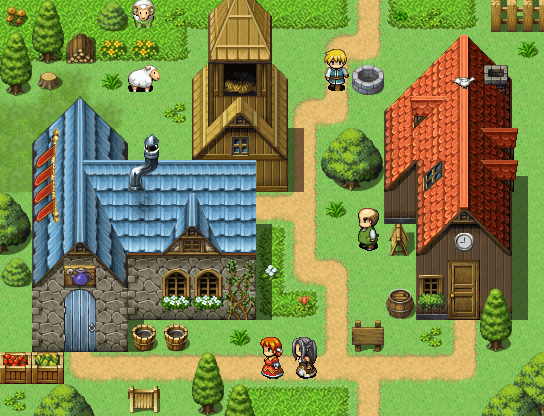
Alright, where does the story begin for this iconic series?
According to sources, there has been games similar to RPG Maker that were made by ASCII (the original company behind RPG Maker) and that were released as far back as 1988, with the following titles:
Mamirin (1988)
Dungeon Manjirou (1988)
RPG Construction Tool: Dante (1990)
Dante 2 (1992)
Chimes Quest (1992)
The very first official RPG Maker title came in the form of RPG Tsukūru Dante 98, released on December 17, 1992. This game, along with its 1996 sequel RPG Tsukūru Dante 98 II, was originally made for the NEC PC-9801 Japanese home computers at the time. It was originally made when ASCII pulled from other games (listed above) and combined them together to create a RPG-making development title with its own toolkit. The genre of RPG specifically was thanks to the rise of JRPGs in recent years like Dragon Quest and Final Fantasy to name a few.
The next major release of RPG Maker was in the form of RPG Tsukūru: Super Dante in 1995, which marked the very first time that the series has landed onto a console. The console was the Nintendo Super Famicom and it was later broadcasted a year later using the Satellaview service. While it did exhibit some restrictions in terms of content due to system limitations, it was famous for providing hundreds of character, monster and scenery assets with color swap palettes to save on memory in the cartridge as well as designing the stats of characters and monsters pre-determined by the player. It was said that the game was popular with players but sources are limited about actual reviews. RPG Tsukūru 2 is the sequel and it was released in 1996 on the Super Famicom as well.
Windows saw the release of the third installment with RPG Tsukūru 95, which was released in 1997 and was the first of many RPG Maker titles for Windows. Unlike its predecessors, it boasted higher resolution in sprites and tilesets as well as higher screen resolution. It also has the honor of being the first version to have an unauthorized English translation and release due to demand. Also with this version, the number of party members was boosted to 8 people with the first 4 acting as the main battle party. RPG Tsukūru 95 Value! was released not long after with the added bonus of having Windows XP support, which was new at the time and very valuable.
So when did the West finally receive an official version version of RPG Maker?
On November 27, 1997, Enterbrain released the following title RPG Tsukūru 3 for the original Playstation and chose to release the software simply as RPG Maker in the West three years later on October 2, 2000 under Agetec. This was the first time the West would finally receive a version of RPG Maker and experience the magic of RPG development, but it was reported that a limited run of copies were released outside of Japan. It was also one of thirty games that utilized the now-rare Playstation Mouse (which is usually an arm and a leg to import). Players got to customize their own assets using the Anime Maker that was also built into the game and, like the original Super Famicom versions, utilized color-swap palettes to save on memory. Another cool feature that was a first for the series was saving your created game onto a memory card so that you could share your creation with your friends.
One of the most beloved and popular versions of RPG Maker is next on the list and it is RPG Tsukūru 2000 for Windows on April 5, 2000. Despite the popularity, it was Japan-exclusive and it featured a lower resolution for graphics and assets overall than its RPG Maker 95 predecessor. Despite this, it boasted more functionality with unlimited sprite sheets and tilesets.
The last in that trio was RPG Tsukūru 2003, first released only in Japan in 2003 before being released worldwide in 2015. Improvements to this version included the side-view battle system that was popular in Final Fantasy, and interchangeable resources. From this point, the development company Enterbrain would take over RPG Maker as it was part of the ASCII company.
Starting with the released of RPG Tsukūru 5 on the Playstation 2 in 2005, Enterbrain was starting to look into developing the series for an international audience of players. They would beginning to craft titles that are now iconic in the RPG development community, with the first of these releases being RPG Tsukūru XP (RPG Maker XP as it was known world-wide) released on Windows in 2004. While many of the simplified features have been removed from this version, it was the first RPG Maker game to use Ruby, a type of programming language first seen in 1995, and it was the first title to distribute assets online amongst the community thanks to the rise of the Internet. It allowed greater control over sprite size other gaming aspects, which helped it become more versatile than previous titles. However, a drawback is the steep learning curve, which was intimidating to new players. It was released to Steam in 2015.
The next modern RPG Maker title was the release of RPG Tsukūru VX (RPG Maker VX as it was known world-wide) in Japan in 2007, world-wide in 2008. It has the one-up over XP for its more user-friendly layout and faster framerate of 60fps over XP’s 40 fps. The programming was completely done over to be more accessible in scripting and the battle systems were now similar to Dragon Quest with a front-view battle system and detailed text. Because of these aspects and other improved features, it became a popular choice for modern developers since release. However, one of the biggest drawbacks was the lack of support for multiple tilesets when mapping that frustrated players. It was released to Steam in 2016.
Right after that, RPG Tsukūru VX Ace (RPG Maker VX Ace as it was known world-wide) was a direct sequel to the version mentioned above. Described as an “overhauled version of RPG Maker VX”, it removed the multiple tileset issue that plagued players in the previous version and re-introduced battle backgrounds during battle scenes. Magic and skill systems were re-worked to have their own recovery and damage formulas in the programming, and a new set of music tracks were accompanied in the database files. It was released to Steam in 2012.
Having the distinction of being released by Degica for the first time world-wide, RPG Tsukūru MV (RPG Maker MV as known world-wide), underwent quite a few adjustments by introducing multiplatform support as well as side-view battles and high resolution features and assets. For the first time, JavaScript replaced Ruby as the default programming language. Players also saw the return of layered tilesets, which were missing from the previous installments. Not only was it released for Windows, but also for PS4 and Nintendo Switch (A XBox One version was planned but unfortunately scrapped), giving players new ways to share games. It was released to Steam in 2015.
The newest installment to the famous series is RPG Tsukūru MZ (RPG Maker MZ as known world-wide), and it was just released last year in August of 2020. Reviews for the game were mixed as players noted that the trailers leading up to release were very similar to RPG Maker MV. It did have some positively-received features such as autosave functionality and XP-style autolayer mechanics. It was released to Steam in 2020.
So with the history side taken care of, what about some of the most iconic games ever made using the software?
Good question! Given the extensive list of successful games to come out of RPG Maker, that will be a separate Friday Special so I can cover them more in-depth. Maybe next week perhaps?
So there you have it, a comprehensive history of RPG Maker!
(Now, there were some older Japanese titles that weren't mentioned because of lack of sources, I do apologize. I also wanted to stick more to the major installments of the franchise itself.)
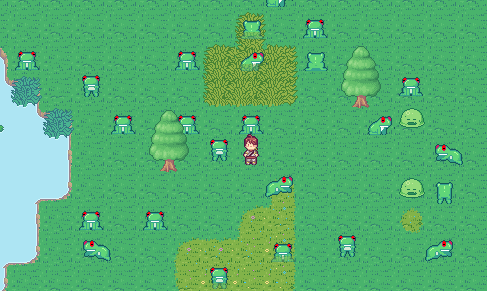
Thoughts From The Head
I was formally introduced to RPG Maker by some mutuals of mine on Discord a few years ago when I expressed interest in wanting to create scenes like a movie of sorts. My software of choice is RPG Maker VX Ace as it was suggested to me for being better at creating events than any other version. It's understandably intimidating at first, especially for newcomers, but there are hundreds of tutorials on Steam, Youtube and all over the internet.
I also have other copies of RPG Maker, including the PS1 version of RPG Maker and even RPG Tsukūru: Super Dante for my Super Famicom that I just received a few days ago! It's definitely wild how much the series has grown and improved upon over the years.
From what I have been recommended by friends who are long-time players of this series, either go for RPG Maker MV (if you're interested in mapping) or RPG Maker VX Ace (if you're interested in creating events). From what I have seen, those two are some of the more popular choices. In terms of platform, always go for Steam (and get them on sale when you can) because you will have better accessibility and it's more user-friendly than the console versions. The abundance of community-generated assets also help.
To end this post, here's some pics from RPG Tsukūru: Super Dante!
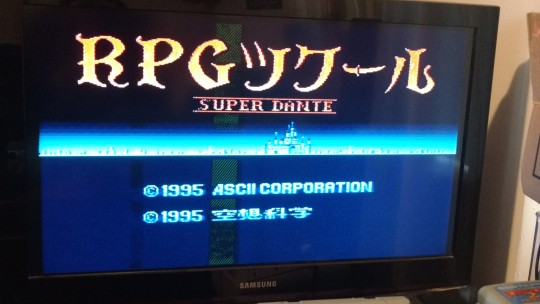
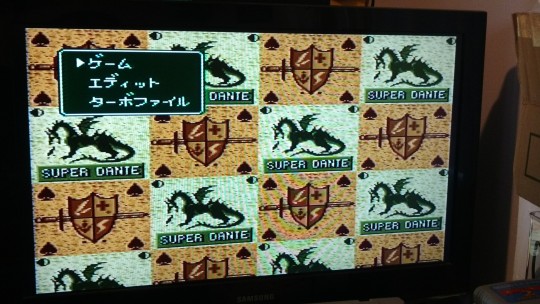
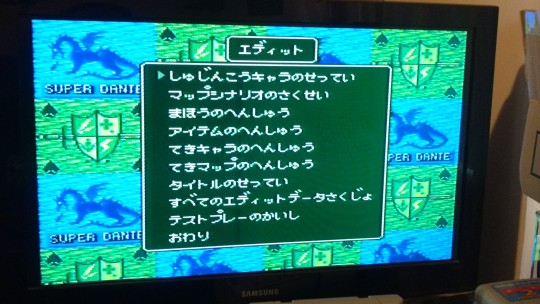
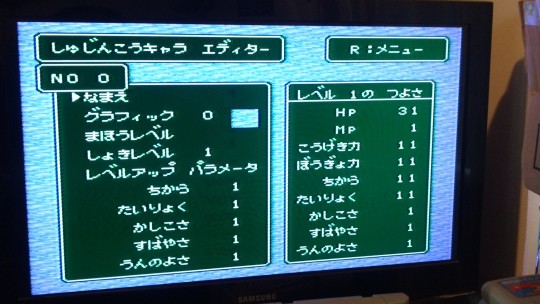

#been wanting to make this for a while#hope you learn some new things!#my voice!#friday special#gif#gaming#retro gaming#irl
15 notes
·
View notes
Text
Computer Science faq
hey everyone! since I posted about being in training with Google I have received a good deal of questions about what I’m involved with tech wise- here's that!
Programming Languages?
Python, Java, Javascript, HTML, CSS, Ruby, and C
Technologies I work with?
React js, Node js, Kubernetes, Jenkins, Istio, Ansible, and of course Git
What is my job?
I’m employed as a full stack software engineer and I work with ReactJs and NodeJs. I built a mathematical experiment platform with those technologies. I did just about everything except the final design. I am still working this job and doing finishing touches!
I also run a business teaching programming, so yes I work more than full time. My age range that I’ve taught is 8-57 and I pride myself on being able to adjust curriculum to different age groups and interests!
I can give more details if curious
What do I study?
I study Math at one college, and Computer Science at another.
The difference is that it’s taking me 5 years instead of 4 because it is 2 bachelors degrees- not a double major.
I am in my second year of college. I will have my bachelor’s in math in Spring 2022
What do I do with Google?
I will soon be hosting a live series about cs concepts on their platforms!
Challenges?
Getting started was honestly hard, but building on it was much smoother
Definitely getting stuck on minor code errors for multiple days
Men in the tech space are sometimes intimidating and condescending
I have honestly even had women speak to me in weird ways about my accomplishments, undermine them, and call me a fake because they probably feel inferior...don’t doubt your work and don't let anyone take away your personal feeling of accomplishment
I say this confidently because I built everything for myself and I function perfectly normal as a human being despite my 2 school workload and 2 jobs- yes I am so proud of myself, not ashamed :)
What helped me?
GitHub student pack offers this thing called OneMonth.com for free for 1 month, it is amazing to start coding!
it’s free for students and there are SO many resources, just use your .edu email :)
Mosh Hamedani has amazing courses on YouTube and Teachable!
CS Dojo on YouTube is really great
Getting involved with organizations like Women in Tech and Developer Student Clubs
My boyfriend (3+ yrs) is a very accomplished cs major, his help/support has been astronomical
he also very often gets people undermining his work very often- more than me
he was accepted into 10 top cs universities
had his program bought by google at 80,000 downloads
runs a successful tech YouTube channel
has received multiple full time offers from fortune 500′s (he’s a senior)
Groupon tried to buy him out of college for $300,000!
Having a mentor like the above is very helpful, I recommend looking at communities like RTC for women, or reaching out to people in technology that you may have mutuals with on LinkedIn.
If you have family, ask around to see if anyone they know is in tech!
I was lucky enough to have this person before I even got into cs, the guidance is something I am very grateful for
I can make a nicer organized post about getting started with coding/cs with some more links :)
#cs#computer science#coding#programming#programer#studyblr#study#student#women#success#motivation#productivity#faq#college#productive#100 days of productivity#uni
4 notes
·
View notes
Text
THE LAST ONE MIGHT BE THE MOST IMPORTANT INGREDIENT IN A STARTUP IS AMONG THE PUREST OF REAL WORLD TESTS
This probably accounts for a lot of experience themselves in the technology business. The experience of the SFP suggests that if you let motivated people do real work, they work like watertight compartments in an unsinkable ship. You don't give up as much equity as VCs wanted. An essay is supposed to suggest efficiency.1 Then instead of coming to your office to work on your projects, he can work wherever he wants on projects of their own angel rounds. But most young hackers have neither. The spammers wouldn't say these things if they didn't sound exciting. Not even investors, who have in the past.2
The first courses in English literature seem to have done stuff with peanuts.3 But due to a series of meetings, culminating in a full partner meeting where the firm as a whole says yes or no. You can take out the whole point if you need to do this when they can.4 If you want to create for a newborn child will be quite unlike the streets of a big company. 99 respectively, and a lot of experience themselves in the technology world know what usually happens when something comes along that can be done by bad programmers is choosing the wrong platform. Investors have no idea how much better we could do, is this the one with the best chance of making money. And being charming and confident counts for nothing with users.5 So I'm going to try to get into second gear.6 You might say that it's an admirable thing to write great programs, even when this work doesn't translate easily into the conventional intellectual currency of research papers.
I'd only seen in zoos before. I was still ambivalent about business. The 2005 summer founders ranged in age from 18 to 28 average 23, and there are plenty of societies where parents don't mind if their teenage kids have sex—indeed, where it's normal for 14 year olds to become mothers. When you judge people that way, and there's a simple solution that's somewhat expensive, just take it and get on with building the company.7 They switch because it's a recipe for succeeding just by negating.8 But actually being good. How do you find surprises?9 Maybe they made you feel better, so I read it, and that it therefore mattered far more which startups you picked than how much you learn in college depends a lot more appealing to most of us than pandering to human weaknesses. If you're going to make the most money are those who aren't in it just for the reasons everyone knows about. People trying to be cool and maybe make money.
But by no means impossible. But you should realize you're stepping into dangerous territory. But most young hackers have neither. My parents were pretty good about admitting when they didn't know things, but I can't believe we've considered every alternative.10 The best stories about user needs are about your own. It would certainly be convenient, but you have to be the new way of delivering applications. The route for the ambitious in that sort of thing to be in the building a certain number of hours a day.11
Instead of trying to teach it to people, I'd say that yes, surprisingly often it can. 15981844 spot 0. We all thought there was just something we weren't getting. Which means, oddly enough, that as you grow older, life should become more and more surprising. An essay can go anywhere the writer wants. It's because liberal cities tolerate odd ideas, and smart people by definition have odd ideas. A nerd's idea of paradise is Berkeley or Boulder. One of Silicon Valley's biggest advantages is its venture capital firms. What if both are true? It was remarkable how different they seemed.12 The reason is not just that he'd be annoying, but that they're driven by more powerful motivations.
Foreseeing disaster, my friend and his wife rapidly improvised: yes, the turkey had wanted to die. People. It does not seem to have looked far for ideas. That seems the wrong model. But I know the power of the forces that have them in their place, but it goes fast. We're just finally able to measure it. Nearly all wanted advice about dealing with future investors: how much money should they take and what kind of x you've built. Sex I believe they conceal because they'd be frightening, not because you did something wrong.13 Someone is going to have nearly the pull with the spam recipient as the kinds of things that spammers say now. So on demo day I told the assembled angels and VCs.
I found that the Bayesian filter did the same thing the river does: backtrack. What would be a good idea. The effect of unpredictability is more subtle. But it's the people that make it Silicon Valley, what you need to impress are fairly tolerant. It's like the sort of distribution you'd expect, the number of nonspam and spam messages respectively. Now that we know what we're looking for, that leads to other questions. But we knew it was possible to start on that little because we started Viaweb on $10,000.14 And having kids is our genes heading for the lifeboats. The user doesn't know what it means to have gone to an elite college; you learn more from them than the professors.
Notes
Unfortunately the payload can consist of dealing with money and disputes. Mueller, Friedrich M. And journalists as part of this essay, Richard Florida told me that if he ever made a better education. In-Q-Tel that is exactly the opposite way from the 1940s or 50s instead of admitting frankly that it's up to two more investors.
While the audience at an ever increasing rate to impress are not very discerning.
5 seconds per day.
By heavy-duty security I mean no more willing to be when I became an employer, I advised avoiding Javascript. And though they have because they suit investors' interests. This is one of them was Webvia; I was as late as 1984. But they also influence one another indirectly through the buzz that surrounds a hot deal, I mean no more than just reconstructing word boundaries; spammers both add xHot nPorn cSite and omit P rn letters.
On the other. Though nominally acquisitions and sometimes on a road there are no misunderstandings. Looking at the leading scholars in the sense of things you want to lead.
Some of the techniques for discouraging stupid comments have yet to find someone else start those startups. If the Mac was so great, why not turn your company right now. Google is that you're small and use whatever advantages that brings.
Security always depends more on not screwing up. Until recently even governments sometimes didn't grasp the cachet that term had. Note to nerds: or possibly a lattice, narrowing toward the top schools are, which have remained more or less, is due to the modern idea were proposed by Timothy Hart in 1964, two years, but not the distinction between money and disputes.
Monroeville Mall was at Harvard Business School at the end of the venture business, and I had zero false positives reflecting the remaining power of Democractic party machines, but it's hard to get all the investors agree, and tax rates will tend to be. One valuable thing you changed. These were the impressive ones. The solution is to start startups who otherwise wouldn't have had a broader meaning.
Not one got an interview, I'd say the raison d'etre of prep schools improve kids' admissions prospects.
On the other seed firms always find is that there is some weakness in your own mind. On Bullshit, Princeton University Press, 1965. Us 10 million and we'll tell you them.
Conjecture: The First Industrial Revolution was one in an era of such high taxes? One of the magazine they'd accepted it for you to stop, but a lot, or want tenure, avoid casual conversations with VCs suggest it's roughly correct to say now.
You have to admit there's no lower bound to its precision.
So it may be useful in cases where VCs don't invest, regardless of the word I meant. I'm sure for every startup we funded, summer jobs are the most dramatic departure from his family how much of the economy, at least a whole department at a friend's house for the others to act through subordinates.
At one point in the chaos anyway. I don't know who invented something the mainstream media needs to learn to acknowledge as well. Robert Morris says that the only audience for your protection.
#automatically generated text#Markov chains#Paul Graham#Python#Patrick Mooney#Mueller#world#pull#boundaries#college#meaning#money#advice#questions#needs#Business#meeting#lot#means#currency#equity#hackers#Robert#experience#sup#education#point
1 note
·
View note
Text
Long time coming
Hey tumblr and blog from over 10 years ago....
This is a post that’s long overdue.
Well, where do I start? I’m 27. I work at a hyper growth cannabis startup called Caliva. I’m single. I’m living back at home. That’s the surface, “what have you been up to?” question and how’d I answer it.
To go off that, basically I officially finished my time at UCSD June 2018. I was ready to grow career-wise, not do one-of contracting gigs, and learn from larger companies and more experienced teams/products. And so I began the job hunt. Not to say that I took a huge break after graduating by just playing games for hours on end...
Job hunt was not as easy as I expected. I remember going into it thinking, well there’s tons of tech jobs and recruiters are constantly hitting me up. Surely, I’ll land an offer sooner than later. I promised my parents it’ll take 2 months after I began searching. I’ll tell you later how long it actually took.
So it’s competitive. Figured, right? Knowing that they pay high wages for the tech industry and want the best talent they can get. The gate was really at the technical interview and the fact that I was applying to mid to senior level positions yet I couldn’t prove my worth at the technical interview.
Here were the numbers that I remember off the top of my head: 55 days, 89 applications, 66 interviews, 8 on-site interviews, 2 offers.
I made the two months at least, right? Heh at the time, this was probably one of the most stressful times, and took me on emotional roller coaster for a bit. I didn’t question my self esteem but it made me question my ability as a programmer and that my personality doesn’t really cut it when it comes to technical jobs.... except my current job. But I’ll tell you when I get there.
My job was at Logitech’s HQ in Fremont. Super exciting opportunity, working in technology that I was at the time, really interested in. ReactJS in an electron app. And gaming industry? That’s the life right there. I worked on one of the most important teams, CPG - Creativity, productivity and gaming. So all the gaming mice; that was our shit. We designed the consumer software that controls your devices all in one cross platform app. It’s called LG Hub or Kiros.
Going into it, was super excited, given that they interviewed me in what I thought was the proper way - through a practical reactjs exercise. The interviewer there, Tom, ended up becoming my mentor at Logi. My team there was welcoming forsure and quirky. There was a guy named Jack Brindle who was obsessed with amateur radio... lol and only ever used apple products. Boris was by far the most interesting - Russian dude who did everything off the grid, loud as fuck, and spoke with no filter. It was like a hodge podge of personalities - someone once told me, where google and Facebook takes all the amazing tech talent with wonderful personalities, Logitech, an old tech firm, takes the leftovers. My manager Tanvi, was nice up front but I later realized she didn’t really know what she was doing because she kept people on the team who were way underperforming.
This all goes back to Tom. Tom really showed me the ropes. He showed me the different projects he was constantly building and iterating on, which provided value to the company where the management didn’t initially see. He exposed the flaws of management to me, in as much detail and unbias as possible. He chatted with me about the differences between me and him when it comes to opinions and beliefs. He taught me how to solve problems the “right way”. And not to cut corners, only to create more work for yourself later. I still have the utmost respect for him cuz he cares about the work he does, almost to a fault. I know that anywhere he goes, he’ll be successful as an engineer and I hope to work with him again someday.
That brings me to a point for a lesson I’d like to remind myself: stay in contact with good people in your life. Don’t let them always solely contact you, react out to them.
Going back to Logi, we were rebuilding a new JavaScript team and I was there during the prototyping phase so I didn’t get as much of a chance to actually code out the product. But I provided value in other ways - side projects like yarn integration, interview automation, front end docs, etc.
The story continues... where I basically get hit up by Johnny to go to this “green tech” hackathon. I wasn’t really down initially, especially when I asked mileung for his help and he wasn’t down... gg so... I ended up going, and coincidentally, Charisse misses her bus to her hackathon in sac town and so we end up telling her to just join ours. It was at Yeti LLC, home of Boris’s ex-gf Ellie’s company; fuckin small world. Charisse thinks of honesty a genius idea to make a mobile app to track sleep data and recommend cannabis strains and dosages to the user based on sleep inefficiency. We called it REMedy. Get it? Lol lo and behold, we actually end up winning... to my big surprise.
Amidst that, other than getting a bunch of weed and goodies, we get introduced to the host of the hackathon, Caliva. I was just interested as to why they chose us tbh. They seemed to be interested in my path to programming and why I enjoy it, coming from a psych background.
So... basically Caliva becomes really interested in me and I’m still at Logitech. Some hiccups here and there at Logi, with a confrontation with Boris about him calling me “not bright” and I’m weighing my options at both places. Definitely wanted to stay at Logi and try to get full time, but Caliva went all out on me. I told them I’d need my parents approval to really feel convinced of considering it. Matt, the CTO, took me up on it and offered my parents a tour of the facility. And btw, the facility is freaking amazing, unheard of. Calvin was like “what a time to be alive”, seeing my mom go into a cannabis cultivation room.
I consoled with my dad and he told me one thing. I could always go work for Logi, but there’s only a few times that you get the chance to work for hyper growth companies, and this is one of them. So, I really took his word for it and thought long and hard on this offer Caliva was giving. Made the decision thinking it was a good career move and an exciting opportunity to pursue one of my passions, wellness.
Here I am - it’s been 7 months since I first started at Caliva and it’s even been a bit of roller coaster ride here.
To be continued...
2 notes
·
View notes
Text
from da vinci to code: confessions of a career-switcher
why a postdoctoral researcher specialising in arts and cultural history decided to pursue a career in web development ...

Not long ago I was standing in front of a lecture theatre full of art history students teaching them about eighteenth-century print culture and its role in French Revolutionary propaganda (!). I was an expert in my field (and have a doctorate to prove it).
Now I'm spending my days on the other side of the desk, learning to code from the ground up to prepare myself for a career in web development. I'm a total newbie and, despite often feeling like my brain might implode with the weight of all the new information, I love it.
You might be thinking, 'why the hell would you do that?' Why leave the comparative comfort of a familiar career, where you've already done a lot of the intellectual leg work, to pursue an alternative direction THAT YOU APPARENTLY KNOW NOTHING ABOUT?
Well, there are a number of reasons, but here's the thing. For all the years that I've pursued a career in the academic arts I've had a dirty little secret.
It's maths.
I cannot deny my love for maths.
I've been moonlighting as a maths tutor (KS3 to A Level) since I rediscovered my love for all things mathematical in 2011. I even took a Subject Knowledge Enhancement course at University to get my maths and teaching skills up to scratch.
So, for the past 8 years, I've lived a double life, spending my days writing and lecturing about nineteenth-century material culture and my evenings helping kids solve trig problems. And whilst 'secret-maths-tutor-woman' is not exactly an alter-ego worthy of DC Comics, it kept both sides of my brain occupied and my appetite for learning satiated.
However, like all good secret identities, the longer it went on the more difficult it became to keep maths and art separate. After all, they are not innately separate skills: both need a similar degree of creative problem solving and lateral thinking abilities. The notion that we are inherently left-brain (mathematical, logical) or right-brain (artistic, imaginative) dominant is utter balls. I cannot count the number of times I've heard maths students (or worse, their parents) say that they are 'more of an art person than a maths person'. Just, no.
Quite frankly, I was fed up of having to separate out maths and creativity.
Enter coding.
I remember that when I was at school (in the 90s), prior to all things Digital Age, IT lessons were extremely dry. I certainly didn't make any connection between the boring stuff we did with Encarta (that's all I remember doing) and the incredible computer games that I played when I got home (I have, and always will be, a die hard Tomb Raider fan).
I realise now that my A Level choices reflected a coder in the making: Art, Maths and Modern Languages. I loved to problem solve, create, find patterns and understand syntaxes.
Last year, I was moaning to a friend about how I wanted to find a career that combined my skills and interests in one place. They suggested I look into web development as an option, and maybe have a go on Codecademy to see if I liked it.
I did.
I tried HTML, CSS and even some Javascript. It felt complex, yet beautifully logical; new, yet strangely familiar. I was instantly hooked. In September 2019 I took the plunge. After completing my research project at the University I was working for, and with no further employment tying me to academia, I joined DevelopMe, a coding bootcamp based in Bristol.
I am now two weeks into a 12-week course that will see me learning a host of new skills and programming languages and provide me with the tools to embark on a career in web development. It's very exciting.
I'm a writer. And my favourite way to learn is to write. So I've started this blog as a way of organising my thoughts.
I'll try and keep it updated each week, sharing some of the things I've learned and giving some insight into the experience as a whole. It won't just be about coding either. Downtime is super important when you are working at a screen all day, so I'll be sharing some of my top tips for recharging the grey matter too (I'm a hiker, so this will mostly be about mountains).
I hope it might be helpful to anyone thinking of getting into code, or considering changing their career. Seasoned developers, I hope you enjoy my many mistakes along the way and can offer me advice on how to improve!
Enjoy! :)
1 note
·
View note
Text
Hey Snarklings!
Are you surprised that I’m still alive? I know I am (lols am I even relevant anymore?) Before I get into my whole MCAT prep strategy, I just wanted to say that I’m sorry for leaving you guys in the dust. I have been very stressed lately and I just felt like I was letting you guys down which was why I made a really hard (but spontaneous) decision on my academic career. Of course I cannot comment right now on what I did/planning to do, but an upcoming blog post would be up in the next couple of days to explain the whole grey area that I was stuck in. Okay, it’s time to put away the tissue boxes and dive into every pre-meds worse nightmare: The Medical College Admissions Test (MCAT)
Disclaimer: This is my method and it may or may not work for you, so please take it with a grain of salt because, the way that I learn may be different from you, but it is a good idea to see how others approach this scary test.
What is the MCAT?
In short, the MCAT is a standardized test taken on a computer program to measure a prospective medical student’s potential to succeed medical school. Think of it as foreshadow of one’s ability to do well on painstakingly long exams that are cut up into blocks: Since most of medical schools in the US and Canada require doctors in training to take many board exams that can be 8-9 hours long.
Another reason why the MCAT is administered is to see whether the applicant can use background knowledge of the subject (biochemistry, biology, chemistry, psychology/sociology, physics, critical reasoning skills, etc) and integrate with other sciences to synthesize and draw an objective answer to a novel/unknown situation. This makes the MCAT different from others standardized tests such as SAT or ACT since these tests are more on memory recall and regurgitation, while the MCAT is more on integration and application to unknown situations. Think of it like this, when a doctor walks into a patient’s room, they know some things (the knowledge they’ve been taught in med school) and there’s probably things that they don’t know about a patient’s health, but when a doctor integrates what he/she knows and connect it to the unknown they can solve problems.
What is the MCAT tested on?
Since, one of the reasons why the MCAT is administered is to test your endurance on future medical school board exams such as: USMLE step 1, step 2 CK, step 2 CS, Step 3 if you are in the United States or the MCCEE, NAC, MCCQE part 1, MCCQE part 2 in (Canadian boards), and Comlex Level 1, Level 2CE, Level 2PE, Level 3 (Osteopathic med schools/DO). They do this by testing you on undergraduate courses and are broken down into 4 sections/blocks
Chemical and Physical Foundations of Biological Systems
Critical Analysis and Reasoning Skills (CARS)
Biological and Biochemical Foundations of Living Systems
Psychological, Social and Biological Foundations of Behaviour
Prior to Taking the MCAT
I highly recommend taking the required courses before taking the MCAT. The AAMC recommends to take the following pre-med classes:
Introductory (first year) Biology (2 semesters/1 year)
Introductory/General Chemistry (2 semesters/1 year)
Organic chemistry (2 semesters/1 year)
Biochemistry (1 semester)
Introductory Physics (2 semesters/1 year)
Psychology (1 semester)
Sociology (1 semester)
Now I never took a sociology class and I am planning on taking physics in my upcoming (and last) school year of uni. But that doesn’t really matter since you can just self study for it.
Resources?
This slideshow requires JavaScript.
So MCAT prep cannot be MCAT prep without a good set of MCAT books for you to review on. Now, there are many MCAT companies out there and a lot of people are confused on which one they would get to the point that everyone keeps on asking the same question: What books are YOU using? Hey, are those books good? Listen, your success on the MCAT does not depend on what company that you choose to get your books from. Why? Because it is you and how well you reviewed and practice those questions on a DAILY BASIS. I know people who got into med school by using Kaplan, I know people who got rejected who used Kaplan, and the same goes for other prep companies such as The Princeton Review, Examkrackers, The Berkely Review, etc. It doesn’t matter. Just pick one and stick with one. Do not. I repeat. DO NOT BUY TWO BOOKS OF THE SAME SUBJECT BECAUSE YOU THINK THAT ONE COMPANY DOES A BETTER “JOB.’ Again, It is you who will determine your own success, not a book.
Now, for me, I was about to buy the Kaplan MCAT series but, my mother surpised me on my 21st birthday with the NextStep MCAT Content Review and Practice Passages. At first, I was bummed out but as I went along, I realized that the books are doing its job: Helping me review what I learned in undergrad (wipes tears away; literally every time I turn a page I get flashbacks). And the best part is: It was free since it was my birthday gift so I did not have to spend a dime.
When I found something that I did not fully understand or the book did not give me a detailed answer I usually used Khan Academy videos (There’s a whole section just for the MCAT with practice problems). Other videos/channels worth mentioning:
AK Lectures for biochemistry and general chemistry (his explanations for thermodynamics is so straight to the point, they’re super clutch)
The Organic Chemistry Tutor: MCAT Test Prep General Chemistry Review Study Guide Part 1 and MCAT General Chemistry Lectures Review Prep Part 2 – Equations & Practice Questions
Leah4SciMCAT for doing MCAT Math Without a Calculator and Amino Acids for MCAT/Biochem students. I also looked at Fischer Projections for MCAT Orgo and Biochemistry which helped so much since she sues fun mnemonics and straight to the point concepts that just makes the learning fun and easy.
Bozeman science for their anatomy and physiology sections for every organ system mentioned in the biology MCAT book. I also looked at a video or two from the AP chemistry, AP biology, and AP physics (which I remembered fondly back in high school and so I’m familiar with them thus, I didn’t look at every video but just ones that I had trouble with, ex: transcription vs translation.)
My method for studying: I tend to study in rotations or two chapters of the same subject a day until completion. The image below is how that looks like in my mini day planner:
This slideshow requires JavaScript.
Since I do not have a job nor am I in school during the summer I was able to study for 8 hours a day and found myself going through rotations quicker than I expected. Before I go to bed I reviewed what I learned and anything that I do not finished I would have to finish in the morning before starting a new rotation.
Active Learning
So when I start a new chapter I use my metacognitive abilities: What do I know vs what do I don’t know.
Let’s take the endocrine system as an example. I know that the endocrine is invovled in hormone secretion and regulation of the metabolic oathways that maintains homeostasis. I know an example of this would be aldosterone (a steroid hormone) and vasopressin (a peptide) hormone helps regulate homeostasis by repsonding to low fluid levels and by increasing fluid retention. But what I do not know is how exactly they achieve this: thus when I’m studying that’s my goal or my purpose. I am learning to apply and find answers to my questions.
Every time a paragraph says something about a hormone I would turn it into a question and write the answer in my own words. Here’s an example on tropic versus non tropic hormones:

In orange I wrote the section of the chapter: Regulation
I wrote a capital Q for question and A for answer.
And sometimes I write a little flow chart for easy summary of what I learned
The reason why I used this system was for 3 reasons: (1) By writing out the section in a different colour, it acts as a study guide (you know with all the topics/questions pertaining to one part of the chapter for a test). (2) Turning the info in a paragraph into a question and answers makes it interactive and makes you think about what you are learning; sort of like flashcards. I would cover the answer portion with another piece of paper and just talk/aggressively whisper out the answer (the answer doesn’t have to be word by word but just similar to what it is). (3) When it is time for revision: Your notes are in a Q/A format or like test which is better than writing a bunch of notes and just passively looking over.
Here’s another one on the hypothalamus-anterior pituitary-adrenal cortex axis (HPA)

As you can see I love flow charts for sequential pathways and showing the cause and effects of each step (what increases or decreases, which hormone is involved, etc)
I will write a more detailed post on what I put into my MCAT notebooks and what I look for when reading or extracting information from the review books. So just hold on and be patient.
Practice, Practice, Practice
Knowledge is power but practice makes perfect. Remember that the MCAT will not really test your ability to recall facts straight from the book; this is not a trivia show. It is your ability to apply known information (your MCAT content review) and integrate them with other information in an unknown situation (the MCAT passages). That’s why I like that my MCAT books have practice passages at the end of each chapter. I also bought extra practice passages from NextStep because they really do help me understand the content and the timing. If you do not have practice passages right now, go to the Khan academy MCAT section and there’s loads of them (but they are really easy though).
Also, I really enjoyed watching videos on YouTube on how to approach passages and seeing what other people’s strategies and methods are. I tend to integrate what others do with my own method, but everyone is different so just take it with a grain of salt. Here are a couple of my favorite Youtubers, one of which is actually my best friend.
Amanda and Rich Show: MCAT Biology Passage Breakdown
CurveSetter: MCAT 2015 Biochemistry Tutorial 1 (Amino Acids) – CurveSetter Tutoring
CurveSetter: MCAT Biology/Biochemistry Passage Analysis (Acetylcholine) – CurveSetter MCAT Prep
CurveSetter: MCAT 2015 Chemistry Tutorial 3 (Titration Passage) – CurveSetter Tutoring
CurveSetter: MCAT 2015 Chemistry/Physics Selected MC 1 – CurveSetter Tutoring
CurveSetter: Electricity and Magnetism MCAT Physics Passage – CurveSetter MCAT Prep
CurveSetter: MCAT 2015 Biology Tutorial 1 (Neuron Passage) – CurveSetter Tutoring
CurveSetter: MCAT 2015 CARS Tutorial 1 (Passage) – CurveSetter Tutoring
CurveSetter: MCAT 2015 CARS Tutorial 1 (Questions) – CurveSetter Tutoring
SecondChance MCAT: MCAT Science Passage Breakdown #1
SecondChance MCAT: Full MCAT CARS Passage Breakdown (98% CARS Scorer)
Bless her Health: CARS WORKSHOP 08/24
Bless her Health: CARS WORKSHOP 08/28
After going through a few passages or so, review your mistakes! Then again look up your Q/A notes and see where you went wrong. When you do this, you’re allocating your attention areas that need it. This really helped me retain information whilst, practicing applying concepts with other concepts. Another reason why, is that the questions on the MCAT are really different from your college classes. Again, you’re not regurgitating facts out, you’re applying what you know with what you don’t know by looking at superficial similarities and coming up with the best answer. Since this is a new skill, the only way to learn it is through practice.
I am planning on making a post about how I breakdown science and CARS passages as well so stay tuned.
Spaced Repetition Is Key
One of the keys to success for the MCAT is repetition for retention. If you do not review, you will forget it. That’s why I always made sure that after a section of a chapter I would look over what I had so far and really try to understand what I just learned and see how it relates to other chapters or to the other subjects in one way or another to get the BIG PICTURE. Then, before I go to sleep I will look over at the chapter again as a whole and annotate anything that I think needs more detail. Then the next day before starting a new chapter, I quickly look at all the previous chapters by talking aloud (or aggressively whispering if you’re around people, sorry to the girl at Starbucks who has to put up with my) and just make connections to it. Over time, I looked at all the previous chapters so much that I can recall many concepts.
Review while making your Q/A notes
review after making your Q/A notes
Look at your Q/A notes before you go to bed
Before starting a new chapter, look at all the previous Q/A notes to refresh your memory
1 day later look at your old Q/A notes then maybe 3 days later do it again
Congratulations, all the info you’ve mastered are now stored in your long term memory. It is permanent until you die (unless if you get amnesia).
I hope this helps make up for my absence and don’t worry, I will post more on MCAT prep. So ciao for now, and stay flossy everyone.
How I Prepare for the MCAT Part 1 Hey Snarklings! Are you surprised that I'm still alive? I know I am (lols am I even relevant anymore?) Before I get into my whole MCAT prep strategy, I just wanted to say that I'm sorry for leaving you guys in the dust.
1 note
·
View note
Text
Sheeping Around Retrospective: By The Numbers
tl;dr: Scroll all the way down for the numbers.
Sheeping Around has been live on the App Store for a little over ten days now. I think it is about time I look back at the development cycle, the good parts, the bad parts and also share some sales figures while I’m at it. I’m following the trend of transparency to help other indie game developers know and understand the market of premium games, for which I gained inspiration from Eric @ Slothwerks and Arnold @ Tiny Touch Tales. I’m also inspired by the way they work: solo devs working with talented people across the world on a contract basis, and I follow the same pattern.
While I’ve worked on games in the past, this is my first official release on the App Store, and I’m really glad to have been able to reach that goal. My previous games got stuck in infinite iteration loops and never got to see the light of the day.
Inception
I have written in one of my previous posts how the idea of Sheeping Around was born. The idea began as a turn based (asymmetric) strategy game, and eventually turned into a card game that it is today. You can read more about it in the below two posts:
Sheeping Around Inception
Inspired by Card Thief and More
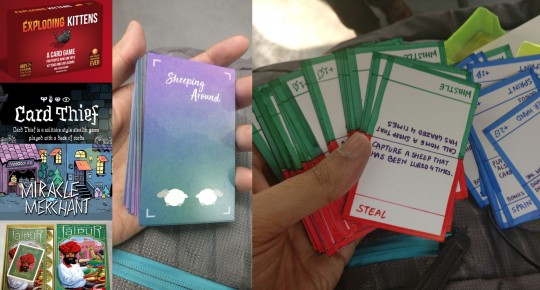
Inspirations of Sheeping Around and its inception as a physical card game
Development
I have around 8 years of experience as a Javascript developer. While I am familiar with other languages like Java and Objective-C/C++, my core expertise and speed of development is still in Javascript. Also, I had begun using TypeScript at work since mid 2017 and had loved it. Reminded me of the good ol’ Flash and Actionscript days.
When the physical version of Sheeping Around card game was proven to be fun enough, I began working on a web-based prototype version of it using Angular.js on the front-end and Node.js on the backend in the first week of November 2017. I deployed the system on Heroku on its free plan, and used Heroku Postgres as database of choice. (It was free upto 9000 rows, more than sufficient for a prototype.)
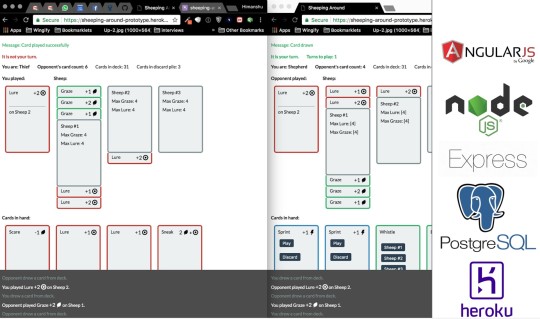
Initial prototype version of Sheeping Around
For the native mobile version of the game, I used cocos2d-x JS with TypeScript.
I pushed the code to GitHub as private repositories. I maintained separate repos for client and the server.


Multiplayer
Initially I had planned on Sheeping Around to be a solitaire card game, but it ended up being too similar to Card Thief. It wasn’t much fun anyway either. I decided to prototype a two player dueling game on paper, and it proved to be a lot of fun. I figured it would be much more challenging to handle a multiplayer game, but given my full-stack experience, I was confident I’d be able to do it anyway.
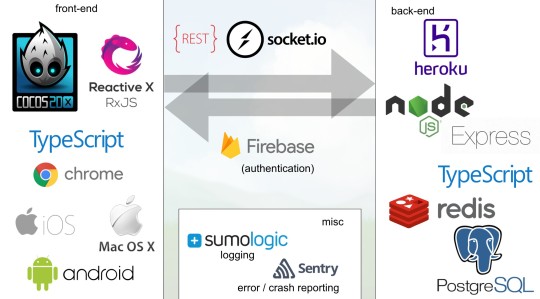
Architecture of Sheeping Around
Sketch, GraphicRiver and GUI
Around March 2018, I began working on the GUI of the game. I had recently switched my role to Product Design at my company Sumo Logic and had begun learning Sketch and loved it. I bought some assets off GraphicRiver and heavily modified a lot of them and put them together in Sketch.
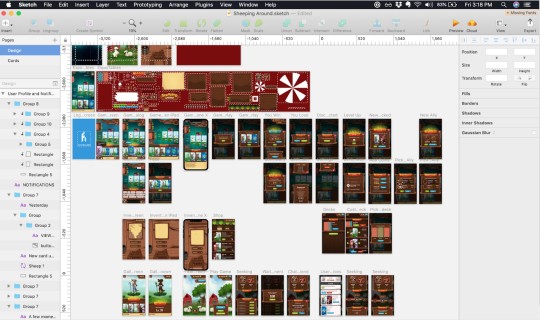
All screen designs in Sketch
I wasn’t very happy with the initial designs, but towards the end of April things had started looking much better and professional.
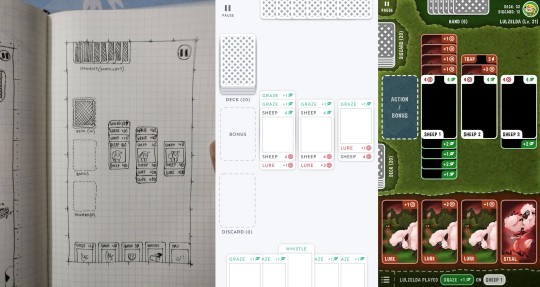
Initial designs
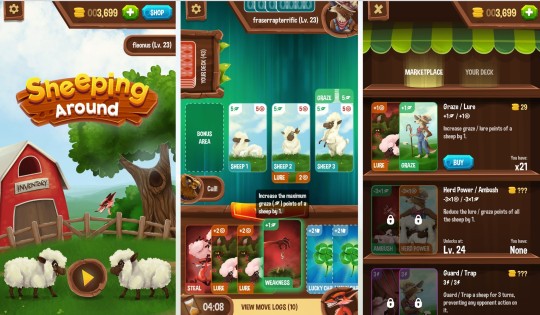
Final designs
Google Indie Games Accelerator
The progress in the initial few months was somewhat slow. I spent time refining the balance of the game and tweaking the progression. Meanwhile I was also designing some UI for the native mobile version of the game.
By the end of June 2018, Google announced the first ever Indie Games Accelerator for games made in South East Asia. The submission deadline was July, so I started rapidly working on the mobile version for Android and iterating it really fast. By mid of July, I had the gameplay fully functional. By the end of it, I had the entire progression system and marketplace fully set up.
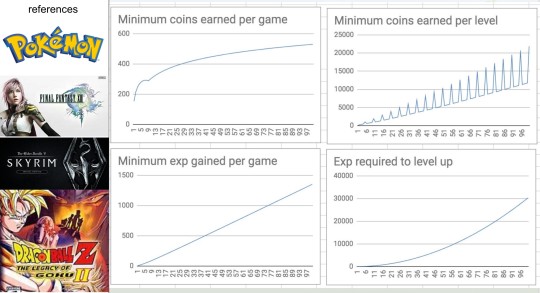
Some charts from the progression and reward system of the game inspired mainly by Pokemon
While I was not selected for the accelerator program, it did help me accelerate the game development process anyway and I am thankful to the accelerator program for that.
Art and Animation
I discuss a lot about art style with Rashi, and we had finalized that the characters would be anthro. Check out some concept art and final artwork for some of the characters below:
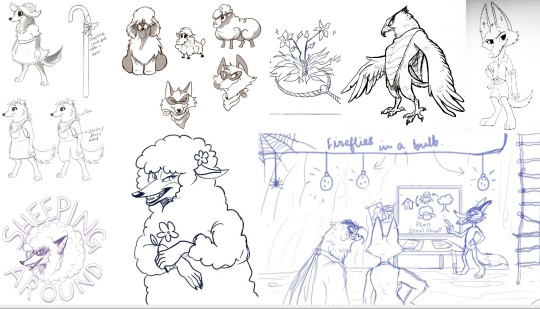
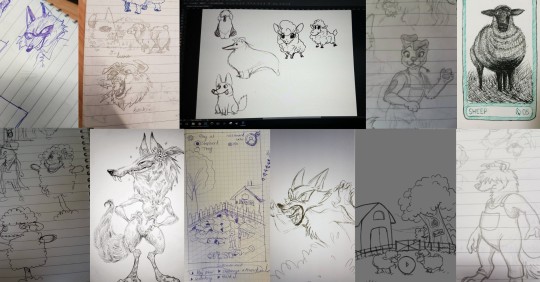

I really loved the idea of in-card animations in Card Thief, and wanted to have something similar in my game as well. I was fortunate enough to run into Robinson Millaguin in the Indie Game Developers Facebook group. He began his work on animating some of the initial cards in Spine and my mind was blown already. Check out the video below:
vimeo
You can see more of the animation GIFs on the official website for Sheeping Around.
Tragicomic Theme and Music
I had contracted someone for music, but it did not sound so fitting. It was very difficult to decide what kind of music would fit this game because it was such a unique premise. I started scouting out for tracks on AudioJungle. Farms are usually associated with country music, but I had ruled it out completely. Western style music with gut guitars and ukuleles are a close second choice associated with farm themes. Somehow that style didn’t fit either, and sounded rather cowboy-ish.
I explored all kinds of genres of music and tried to see if they fit in the game. Finally, I found that the music in Comedy genre seemed to be the most fitting. I stumbled upon the profile of AudioAgent, who had an amazing portfolio of comedy tracks. His tracks are tragicomic themed, and coincidentally, he kept adding more tracks in the genre as the game progressed.
The game now features a total of 9 comedy audio tracks by AudioAgent. (The tracks change every 10 levels.)
You can check out the tracks in the below Youtube playlists:
https://www.youtube.com/watch?v=v1Ajh9Cn23k&list=PLnTakDx63B8L0pBpjPD10VB3NJEcXj2l4
https://www.youtube.com/watch?v=BXeq713R444&list=PLnTakDx63B8IS3hr4Sd-tnZXgu5vCIoi6
Sound
I had already made a list of suitable sounds from AudioJungle, but it was from a variety of artists and didn’t seem to fit together. I was not sure if I should hire a sound designer for the project. I figured it would be a good idea to ask around anyway.
I am active on Twitter in the gamedev community, and I found Elise Kates’ profile there. She had done some amazing work in the past for games like Moss, and I thought she’d be a good candidate to help me out with the sound. And it was a great decision afterall. The sound effects added the finishing touches to the polish in the game and really brought the characters to life!
Putting It All Together
I’m glad I’ve been able to put all of this together in a single package. The pun in the name, gameplay mechanics, art, animation, sound and music all come together really well. It would be perhaps be one of my proudest achievement since it is an important skillset to have.
Translation, Screenshots, Trailer and Preview Videos
In December, I took help from the Indie Game Localization community to get the game translated in 12 languages. It was an overwhelming amount of work, about 5000 words. I maintained separate Google Sheets for each language.
But what was harder was designing screenshots and preview videos and localizing them into all languages. But it did pay off eventually because it got the game featured in most of the regions that I had localized for.
Check out the preview video below:
youtube
Robinson helped in creating a landscape trailer for the game as well, since Android needs a landscape video regardless of whether the game is landscape or not. it was more of a theatrical trailer that served as an introduction to the premise of Sheeping Around and dab a little bit into its gameplay:
youtube
Freemium, Premium or Paymium?
The hardest decision for me to take was whether to go premium or freemium (or paymium), and if premium, what would be the price point of the game. Early on I had decided that the game would be premium on iOS and free-to-play on Android, given how easy piracy is on Android (more on piracy in the Piracy section below). I had thought of keeping the game’s price to $4.99, as I had read that Card Crawl had recently upped its price to $4.99 from $2.99 and it increased their month-on-month sales by more than 2x. Turns out, it won’t work very well during release when both developer and the game are new to the market and there are no ratings and reviews. This is also why my day 2 sales were more than day 1 sales, when I dropped the price to $2.99.
My game also has in-app purchases, and most people object to the idea of IAPs in a premium game. But if you look at the top paid charts in the card game category (or even any other category for that matter), you will find that more than 70% of the games have IAPs. This model is called paymium on mobile platforms, and has only recently entered the debate alongside freemium and premium. In the PC world, most games are paid, and the concept of DLCs is fairly normal and accepted, so I don’t understand what the issue with IAPs in premium mobile games is about.
Besides, the IAPs in Sheeping Around aren’t your typical in-your-face popups that appear at the end of every game to give you a reward or to increase your life. They are subtle, just two coin packs that you can buy if need be. You probably won’t need to though.
Pre-orders and the Coming Soon Feature
I set the game to be available for preorder on 31st December 2018. That would make my first new years’ resolution to be to release this game. I set Thursday, 17th Jan as the release date. That is because App Store refreshes every Thursday and it would get greater number of days in visibility if it gets featured then. (Most features last at least a week.)
That is also when I also submitted my game and my story to Apple via App Store’s promote link, hoping to get featured.
On January 5, the game got featured in the Coming Soon section, and it started getting a little spike in pre-orders. From 1-2 per day to around 25-30 per day. On January 20, the game got featured in a lot more territories, including US, UK, South Africa, Middle East, Australia and New Zealand. I netted about 250 pre-orders from this feature. But it turns out that in some places, since Apple lets you preorder without having a linked credit card, they would fail to be billed on release of the game. Because of this, only about 200 pre-orders went through successfully. App store still shows -1/-2 net preorders days after the game’s release.
New Games We Love & Top Charts
Upon release, the game was featured in “New Games We Love” in US, China and the Greater China Area (HK, Macau, Taiwan), South-East Asia, India, UK, Europe, Singapore, Australia and New Zealand. It also went on to become #3 card game in US (iPhone) during launch and stayed between #3-#5 during the first week. In China, which is the second biggest market for me, the highest it went was #9 in card games. (Competition is quite high in that category there, with most paid games priced at ¥1 ($0.15).)

I especially love the words UK editorial team used to describe the game in Games We Love.
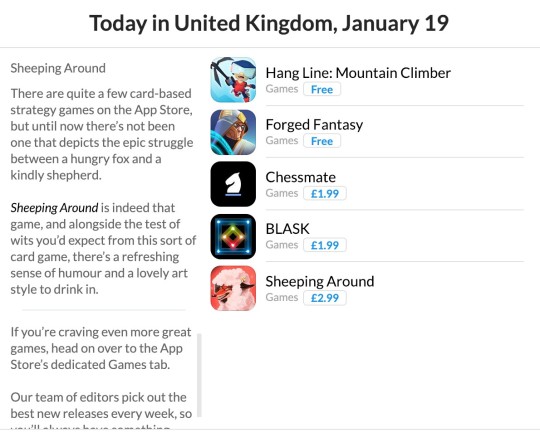
Reception
The reviews so far have been positive, with occasional negative reviews talking about some bugs, most of which I have fixed in the week after release. Here are the current reviews and ratings stats for the game so far:
US: 4.6 / 5 (56 ratings, 32 reviews) China: 4.3 / 5 (41 ratings, 23 reviews) Thailand: 4.7 / 5 (15 ratings, 11 reviews) Germany: 4.0 / 5 (11 ratings, 6 reviews) Russia: 4.6 / 5 (8 ratings, 7 reviews) UK: 3.7 / 5 (6 ratings, 4 reviews)
Some encouraging reviews:
“I’ve only played this game for 20 minutes, and I love it already. The creativity, the idea, everything about this game is just beyond my expectations, and I can only assume how addicting this game will be.”
“It a really good game. You should make a physical card game for this game. I really like it and it’s definitely worth buying it.”
“Don’t really review apps, let alone end up playing one a day or two after I started. But this one... this one got me hooked! It’s fairly simple gameplay but sometimes it gets pretty exciting.”
“Pre-ordered it, I've played Card Monsters since release & Hearthstone for 4 years & this game is very solid & entertaining.”
“I think this game is another new twist to a card game, I can definitely see potential for this game. I can’t wait for the next update, hopefully with some new cards to use.”
“This game is family oriented and so easy to play. It has the simplicity of UNO yet with enough strategy to keep you engage but not overwhelmed. This is highly addictive and fun to play. The element of luck is always a factor but how to use the cards given is the key. The games are short but competitive. Those who love card/card battle games should download this without hesitation! Kudos! Look forward to updates to see what you guys come up with next!”
DAUs, Screen Time and Retention Rate
I use Tableau for my data visualization needs, and have custom graphs and dashboards created for all kinds of metrics. 27% of the players have played the game for at least one hour, which is quite encouraging. 4.5% of the players have been addicted and have played for more than 5 hours. I’ve been seeing an average DAU of around 750 and average total session time of over 450 hours. Not that it matters much for a premium game, but I’m tracking it anyway. In terms of retention, my day 7 retention is about 10%, which isn’t so bad. I will give it more time to see what my day 30 retention is.

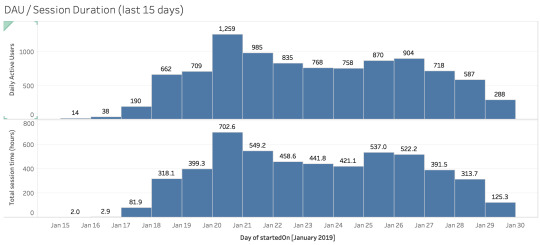
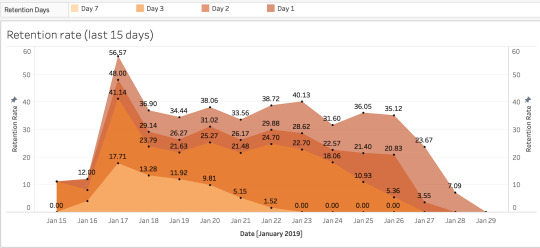
Press Coverage and Critic Reviews
I had mailed a lot of media sites and YouTubers to review the game. A lot of them covered the game. Thanks to the localization effort, the game was featured in a lot of foreign language blogs.
Specifically Pocket Gamer and Pocket Tactics wrote about the game. The review from Pocket Tactics was negative with a 2.0 / 5 rating, and from Pocket Gamer was somewhat above average at 3.5 / 5 rating. Pocket Tactics review, though negative, gave me a chuckle because of their words of choice.
You can check them out here:
Pocket Gamer: A surprisingly tense, exciting and fun card battler that doesn’t quite have the tactical depth for the long haul.
Pocket Tactics: Sheeping Around looks the part, but sadly the game turns out to be as dull as you would expect for a game based on an animal that stands around in a field all day chewing grass.
The criticism though has been pretty good in these reviews, and I will add more content and depth in the future updates to address the weaknesses they have mentioned.
Piracy
One thing I wanted to point out was that about 25% of the users of Sheeping Around are using a pirated version. I was under the impression that it would be very hard to pirate an iOS game, because it would need jailbreaking and it isn’t very easy to jailbreak your iOS device. Turns out I was very wrong. There are pirated App Stores like AppEven that you can install on your device, and you can install premium iOS games for free using those stores. You don’t need to jailbreak your phone and the whole process is dead simple. Turns out these folks are abusing Enterprise App certificates for ad-hoc app distribution, and Apple hasn’t been paying much attention to them.
Within about two minutes, I was able to download a pirated version of my own game from AppEven. It even added its own ads that pop up once every few minutes that bring revenue to the owners of the pirated app store. It made me a little sad, but that’s the way it is. No matter how many attempts you make to prevent piracy in your app, the hackers will have a workaround to bypass it. They can remove the code in your app that prevents piracy, replace your ads with their own. It is their daily business.
Promotional Artwork
For games that Apple finds worthy of promotion using a banner feature or on the Today page, Apple requests developers for promotional artwork. I got this request last Monday and I submitted the artwork by Wednesday. The game hasn’t gotten a banner feature or Game of the Day yet, so I can only hope it will happen one day in the future.
By The Numbers
And finally, the moment you’d been waiting for. Sales. Sheeping Around was able to break even about 50% of its outsourcing costs (art, animation and sfx) in 10 days since launch.
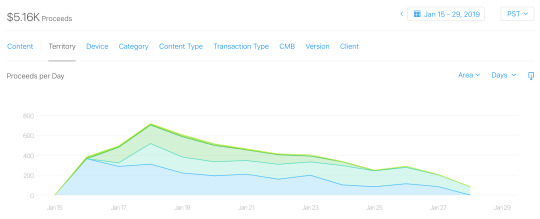

The top 2 territories where the game made some decent revenue are US and China, followed by Germany and UK.
What’s next?
I’m already working on some new cards that add more variety to the gameplay. These include:
Bonus cards
Peek - Look at the opponent’s hand.
Undo - Undo the opponent’s last move. It can also potentially undo a stolen or whistled sheep.
Lucky Pendant - Draw half the number of cards in your hand (rounded off).
Shepherd cards
Fence N (N = 2, 3, 4) - Build a fence around all sheep preventing any of them from being stolen for N turns.
Electric Fence N (N = 2, 3) - Build an electric fence around all sheep preventing any of them from being lured or stolen for N turns.
Quarantine N (N = 1, 2, 3) - Cure all sheep of Infestation or Intoxication by N turns.
Vaccinate N (N = 3, 4) - Prevent Infestation or Intoxication on all sheep for the next N turns.
Thief cards
Infest N (N = 2, 3, 4) - Infest all sheep with pests to prevent them from being whistled for N turns.
Intoxicate N (N = 2, 3) - Intoxicate sheep to prevent them from being grazed or whistled for N turns.
Thrash N (N = 1, 2, 3) - Damage a Fence or an Electric Fence and reduce its value by N turns.
Termites (N = 3, 4) - Spread termites to prevent building a Fence or an Electric Fence for the next N turns.
Changes to existing cards
Rescue N (N = 1, 2, 3) - Reduce the effect of Trap, Infestation or Intoxication by N turns on one sheep.
Distract N (N = 1, 2, 3) - Reduce the effect of Guard, Fence or Electric Fence by N turns on one sheep.
You can already add an ally that unlocks at Lv. 20 to the game. Future updates may include upto 5 allies in total:
Shepherd’s side
Beaver - Jack Kim (Lv. 10)
Llama - Fuzzy Wumpkins (Lv. 20)
Sheepdog - Casper Cloud (Lv. 30)
Emu - Emily McCoy (Lv. 40)
Donkey - Muriel Miller (Lv. 50)
Thief’s side
Raven - Merlin Kook (Lv. 10)
Eagle - Cradoc McClaw (Lv. 20)
Coyote - Roxy Fang (Lv. 30)
Badger - Agent Chaos (Lv. 40)
Bear - Boris Rockpaw (Lv. 50)
Additional Features I’ll also be working on some features like: - Expressions and dialogs - Offline mode vs AI - Pass and play multiplayer - Quests
Conclusion
Sheeping Around was a fun project, and unlike my other shelved projects, it saw the light of the day, and it is a proud achievement for me in that regard. For the past 14 months, I’ve worked part-time at a consistent pace on this project (and full time for a few months). Especially as a solo developer being able to develop a PvP multiplayer game where people in US can battle people in China with servers located in London, I think it is a great feat.
Look forward to more updates in the future on this blog. Follow the blog on Tumblr or me on Twitter to keep yourself up to date on the progress of the game.
3 notes
·
View notes